 By Pepper Parr By Pepper Parr
September 26th, 2019
BURLINGTON, ON
A number of weeks ago the Gazette had an email conversation with city manager Tim Commisso who wrote about some of the changes that would be taking place at city hall.
He mentioned at the time that he had 17 direct reports and that he wanted to reduce those considerably so that he could concentrate on the development of a strategy that would fill the direction he was given by council back in February.
Yesterday Commisso put his plan on the table during a closed session of council. The new organizational structure was adopted by Council during the closed session – the public got word of it when they put out a media release. We have absolutely no idea what council thought of the plan – did they ask for changes? Was there a vigorous debate?
The plan looks to be solid. The Gazette learned from a former senior staff member that it was a “plan that should work”.
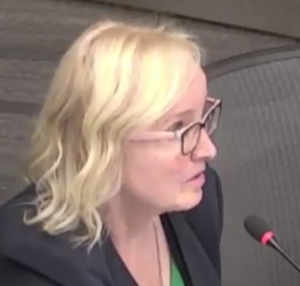 Director of Human Resources Laura Boyd We asked Commisso if the Burlington Leadership Team would continue to operate; recall the Director of Human Resources Laura Boyd wrote in her exceptionally revealing report to council back in July said:
“When the results were further analyzed, it became apparent that communication within the organization diminishes between hierarchical levels.
“Specifically, between the Burlington Leadership Team and the Supervisors/Manager level and then between the Supervisors/Managers level and their direct reports.”
Commisso told us that the “city’s internal leadership/strategic management structure will still encompass: Exec Directors, Directors (Department Heads) and City Mgr. BLT will meet weekly and provide strategic management oversight on day to day City service delivery, review of upcoming Council reports, implementation of Council V2F work plan and other corporate projects. BLT also deals with city policies and procedures, budget development, ongoing council/ staff relations.
He added that “The Strategy and Risk Team (SRT) will meet biweekly and will focus at a more detailed level on corporate strategy execution and related risk mitigation and also reporting on same to Council on a regular basis. SRT is a new leadership team comprised of Exec Directors and City Mgr. SRT will also focus on corporate wide business processes such as customer service, health and safety.
Commisso said “This approach is a best practice for municipal and public sector governance” and added that “We will need to align the new structure with Council’s standing committees and are working on a report to Council on that for Oct.
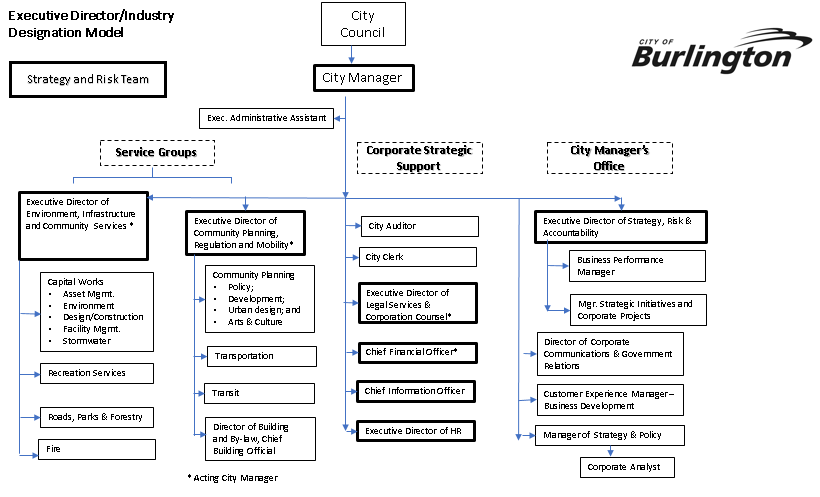 The Gazette wondered aloud during a telephone conversation earlier today if this organizational change was not a consolidation of power in the city manager’s office. Commisso doesn’t see it that way. He did reduce the number of direct reports from 17 to 12 and admits that even twelve is a little on the high side. The Gazette wondered aloud during a telephone conversation earlier today if this organizational change was not a consolidation of power in the city manager’s office. Commisso doesn’t see it that way. He did reduce the number of direct reports from 17 to 12 and admits that even twelve is a little on the high side.
One of the problems Commisso has is the quality of his bench strength – there are a number of senior people not exactly pulling their weight – at the same time there are a significant number of young people who have done well but find it difficult to see Burlington as a place where they can grow meaningful careers – there have been four city managers in a six year period.
You build a team by ensuring that management stability is in place and that it is going to be there for some time and that there will be opportunities for professional growth.
Getting the new organization in place has been a huge task for Tim Commisso; he loved doing the work – says he loves the city. He’s not a talkative man – without ever having had an opportunity to sit opposite the man it’s difficult to get the measure of him.
Our conversation with him on Wednesday was short – he was swamped.
We wanted to ask: Is this just round one of the blood letting at the staff level. It would have been inappropriate of him to respond but the question remains. Many of the keen observers of city hall matter don’t feel the job has been completed.
Strategy is just one part of what Commisso believes has to be put in place. The other is a change in the culture – that one is going to take years – it will have to start soon for staff to buy into it and then years to make changes and make them stick.
Can MacDonald and Magi instill a different more meaningful sense of confidence in staff? Does Human Resources have a handle on just what the problems are and perhaps some solutions as to how to give the place a shot of something?
The Gazette recalls a citizen who once worked at city hall in a very senior job where he was right in the thick of it all. He gave some thought to running for office – actually came close to deciding he would and then decided that it was “too toxic” (his words) and left the public office job to others.
While Commisso can perhaps pull rabbits out of hats (that is not a skill set he lays any claim to) he has to cope with a city council that does not yet have a full year under its belt.
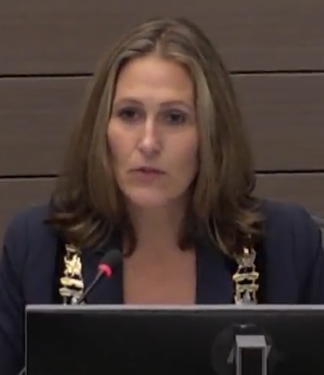 Mayor Meed Ward fully understands the power she has when she wears the Chain of Office. Can her colleagues restrain her? They have done just that a few times. He has to deal with a Mayor who has an agenda and she is certainly pushing that agenda. If he doesn’t have a real concern over how reserve accounts are handled – then he should have. He needs to find a way to counsel the Mayor and educate the newer council members on why we have reserves and the way they should be handled. All five of the newbies have turned to the city manager for advice and direction – when their job is to hold the man they are turning to accountable.
Commisso didn’t think that was a problem. The governance people we spoke to told us that it was a serious problem and that Commisso was walking on this ice.
The mention that Burlington is one of the best places to work just isn’t true. The chaos is disturbing.
With Heather MacDonald and Allan Magi serving now as the management level directly beneath the city manager there is a line of authority and direction that has been missing for some time.
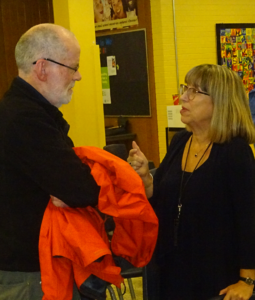 Heather MacDonald, now one of the two leaders working with the city manager to make it all come together in conversation with a citizen at a public meeting. It is going to take a bit of time for the two to get the hang of the job. MacDonald came to Burlington a relatively short time ago to serve as the Planning Director and now finds herself as responsible for the effective administration of a much bigger plate. She was doing just fine with the Planning problems; the Interim Control Bylaw was hers to oversee as well as the re-writing of the Approved Official Plan.
Behind all that there is the pile of development applications that are going to flood the city when the Interim Bylaw gets lifted. There is a lot of work on that table.
Two new positions have been created:
Customer Experience Manager-Business Development
Executive Director of Strategy, Risk and Accountability
They will both be posted on the city’s web site and be open to outsiders.
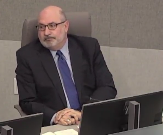 City manager Tom Commisso is often the only senior administrative person at council meetings. He says what he has to say in relatively few words. Commisso believes they are both critical – it will be interesting to see the job description when it is posted. The use of the word ‘accountability’ raised an eyebrow- just what does the city mean when they say ‘accountability’.
This is something we will return to once we see the job posting.
Related news stories:
Director of Human Resources lays it all out on the table.

 By Pepper Parr By Pepper Parr
September 12th, 2019
BURLINGTON, ON
This afternoon city council will be discussing and debating one of the biggest problems the city faces: Managing the growth.
In a story we published earlier in the month we wrote:
“Assume just two people to a dwelling (and that is quite an assumption) we are looking at between 29 and 42 thousand new dwellings.”
This was in reference to a study that was done in 2008 when the City undertook an Intensification Study to better understand the intensification opportunities in the City which could accommodate growth to 2031. It was recognized at that time that the City’s supply of Greenfield land was diminishing and a more comprehensive approach to planning for intensification was needed.
That study focused on key areas within the City’s urban area and included a site by site analysis to identify opportunities for infilling and redevelopment. This study, which laid out a general framework for longer term growth planning in the City, determined a reasonable estimate of residential units, people and jobs, which could be provided through intensification by 2031. The study also concluded that Burlington was expected to exceed the 40% intensification target in the Growth Plan that is applied Region wide.
 While taking the applause did the members of this newly elected city council have any idea how big a job they had ahead of them? The study findings were used to inform the growth analysis work that was undertaken by Halton Region through their Sustainable Halton process, which resulted in population and employment growth forecasts to 2031 as well as intensification and density targets for the City and the other municipalities in the Region.
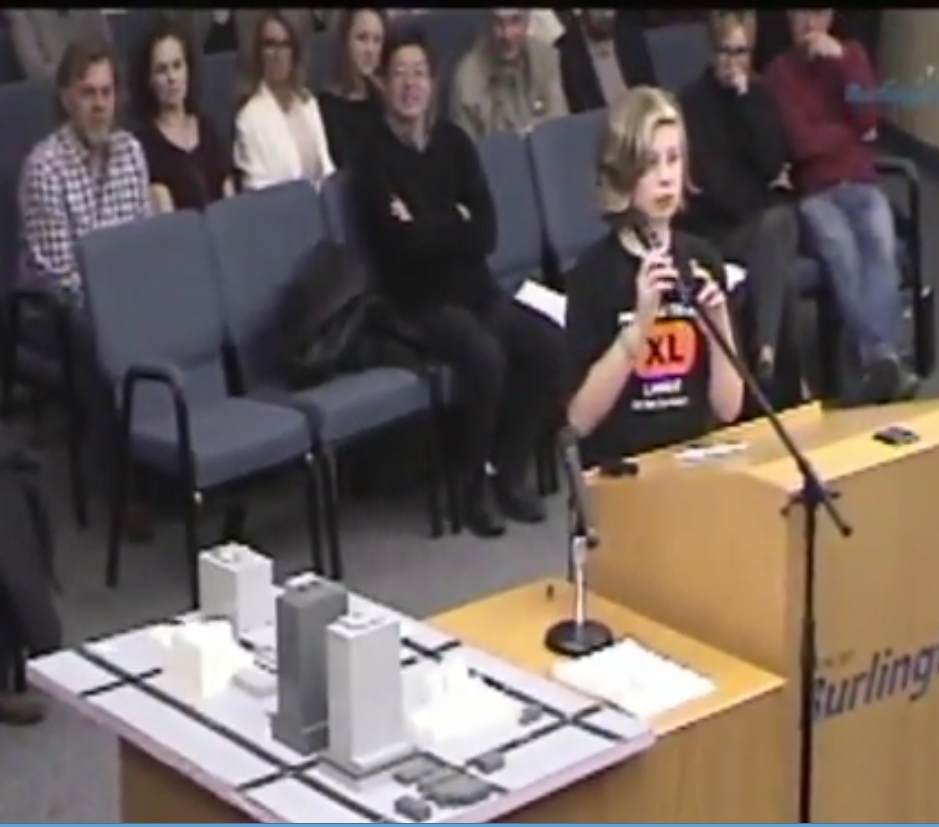 One of Burlington’s younger citizens uses a Lego model to explain to council just what the city will look like when the development being proposed are completed. The city is now preparing their comments and input for the 2041 growth targets, That’s where that “looking at between 29 and 42 thousand new dwellings” comes from. That is a massive number that most people are not fully aware of – the Gazette wasn’t around in 2008 – we would have alerted you.
You can watch the live webcast this afternoon.
They will be talking about your future.
Related news story:
Just how much growth is Burlington going to have to absorb?

 By Staff By Staff
September 10th, 2019
BURLINGTON, ON
Some movement at city hall on the expected application to do more quarrying by Nelson Aggregates.
 A decommissioned quarry site turned into a lake – 30 footballs fields in size. The company has been very proactive and going to some lengths to get its story out – the ward Councillor appears to have forgotten that the job is to listen to all sides of an application.
We reached out to the Nelson Aggregate people and learned that they haven’t heard a ward from Councillor Nisan.
What the Councillor has done is ask his colleagues to support his Staff Direction for the following:
Direct the Director of City Building to report back to the Planning and Development Committee on the land use development application and review process related to the proposed Nelson Quarry expansion, including but not limited to the following:
• summary of the process including decision points;
• anticipated timelines for process steps;
• roles and responsibilities of review agencies;
• a summary of process and outcomes of the previous proposal for expansion; and
• a summary of any the new provincial legislation related to aggregate resources.
All that information is currently in the public domain – If Nisan wanted some additional depth the Deputy City Manager would have told him everything he would need to know and then some.
The Staff Direction move might just be some way of Nisan saying to his constituents: ‘I’m working for you’.
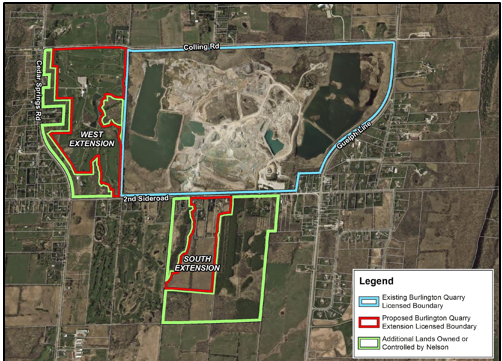 The Nelson offer is to turn all the land over to the city when they have completed the quarrying. Council appears to have taken the position that they will talk to the quarry people when the site has been decommissioned. What Nelson Aggregates is required to do in the way of decommissioning is set out in their license, which the Gazette has made public.
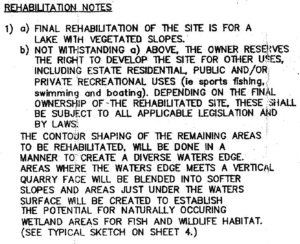 Note attached the one of the Nelson Aggregates licenses. What Nelson is saying is that they have some unique ideas on what they can do with the site when they are finished that will determine just how they do the decommissioning – not whether or not they are going to do it.
Councillor Nisan will never know what they are thinking if he doesn’t talk to them.
He seems to be arming for a fight.

 By Pepper Parr By Pepper Parr
September 3, 2019
BURLINGTON, ON
The City commissioned a Growth Analysis Study to identify an appropriate level of population and employment growth that can be anticipated for the City between now and 2041. The study findings are intended to help inform the growth analysis work being undertaken by Halton Region through the Integrated Growth Management Strategy (IGMS) by providing a finer grain analysis of the growth opportunities within the City of Burlington.
Some of the numbers that are coming out of the reports put the kind of growth the city could be facing in context: an additional 58,321 to 85,863 people and 22,669 to 53,137 jobs between now and full build out. Full build out is assumed to be post 2041 and represents a conceivable end state where land has been fully optimized.
Assume just two people to a dwelling (and that is quite an assumption) we are looking at between 29 and 42 thousand new dwellings.
That certainly put the 2018 election debate in context.
In 2008, the City undertook an Intensification Study to better understand the intensification opportunities in the City which could accommodate growth to 2031. It was recognized at that time that the City’s supply of Greenfield land was diminishing and a more comprehensive approach to planning for intensification was needed.
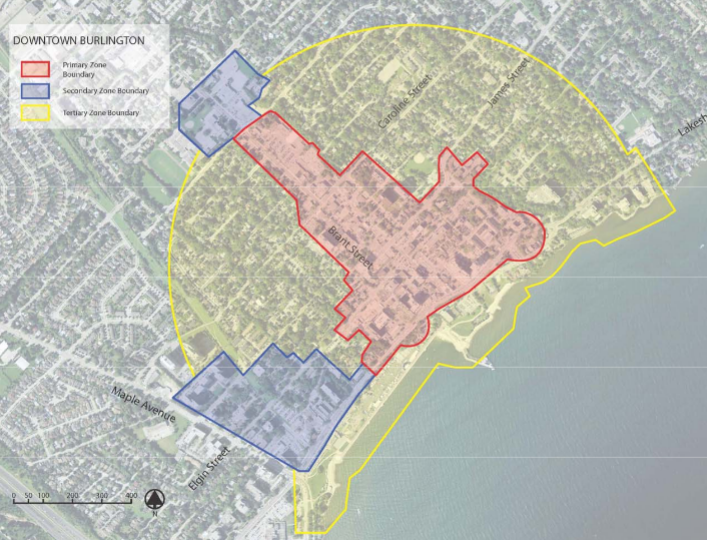 Boundaries set out for the Downtown mobility hub. The study focused on key areas within the City’s urban area and included a site by site analysis to identify opportunities for infilling and redevelopment. This study, which laid out a general framework for longer term growth planning in the City, determined a reasonable estimate of residential units, people and jobs, which could be provided through intensification by 2031. The study also concluded that Burlington was expected to exceed the 40% intensification target in the Growth Plan that is applied Region wide.
The study findings were used to inform the growth analysis work that was undertaken by Halton Region through their Sustainable Halton process, which resulted in population and employment growth forecasts to 2031 as well as intensification and density targets for the City and the other municipalities in the Region.
Halton Region’s Official Plan Review and Integrated Growth Management Strategy
Halton Region is currently undertaking a review of their Official Plan, as required by the Planning Act. The Region’s Official Plan Review (ROPR) commenced in April 2014 and is being undertaken in three phases. Phase one was completed in October 2016 with the completion of a Directions Report which identified the key policy areas for review through the ROPR and established a high level work plan to complete the detailed research and policy development to be undertaken in phases two and three of the ROPR.
 One of the key policy areas identified by the Region is the Integrated Growth Management Strategy (IGMS) which is a growth strategy for the Region to the planning horizon year of 2041 that will incorporate the population and employment forecasts for the Region in accordance with Schedule 3 to the Growth Plan for the Greater Golden Horseshoe. The result of the IGMS work will be an updated growth strategy for the Region and its local municipalities which is based on the integration of land use, infrastructure and financial considerations, that conforms to both Provincial and Regional policy directives. One of the key policy areas identified by the Region is the Integrated Growth Management Strategy (IGMS) which is a growth strategy for the Region to the planning horizon year of 2041 that will incorporate the population and employment forecasts for the Region in accordance with Schedule 3 to the Growth Plan for the Greater Golden Horseshoe. The result of the IGMS work will be an updated growth strategy for the Region and its local municipalities which is based on the integration of land use, infrastructure and financial considerations, that conforms to both Provincial and Regional policy directives.
Phase two work on the IGMS began in the spring of 2018 with a kick-off meeting with the local municipalities. Since then, staff have been actively engaged with the Region on the IGMS work through participation on technical committees, attending meetings and workshops as well as providing background data to support the development of the growth scenarios, which were shared with Regional Council on June 19, 2019.
City of Burlington Growth Analysis Study
Recognizing the growth work being undertaken by the Region through the IGMS as a region-wide provincial conformity exercise, City staff saw the opportunity to engage a consultant to undertake growth analysis work at the local level to inform the process at the Region and provide support to City staff and Council in reviewing and providing feedback to the Region on the IGMS work.
Study Process and Work Plan
In the fall of 2018, the City retained Dillon Consulting with support from Watson and Associates to undertake an analysis of the City’s population and employment growth trends to better understand what an appropriate level of population and employment growth might look like for the City between now and 2041. The study findings are intended to inform and support the process being undertaken at the Region by providing a finer grain analysis of growth opportunities in the City and is not intended to supersede the Region’s process. City staff also recognize that components of the growth analysis study could be used or leveraged for other city projects and initiatives.
The project work plan prepared by Dillon and Watson for the growth analysis study included:
• A review of growth related background data;
• A review of the policy context to gain a better understanding of the long-term growth potential for the City;
• Confirmation of the estimated long-term supply of land within the City for residential and non-residential growth;
• An economic, socio-economic and demographic trends analysis which will also include commentary on local factors and economic drivers which are anticipated to influence future residential and non-residential development trends in the City;
• The development of three city-wide population, housing and employment growth forecasts, including the identification of a preferred growth forecast;
• Identifying potential opportunities and challenges associated with the city’s ability to achieve the preferred growth forecast.
A project kick-off meeting was held in the fall of 2018 which included staff from various internal city departments, acting a project steering committee. Various background data related to land use and development was also provided to the consulting team to assist with their review and analysis. In March 2019, a workshop was held with internal city staff which provided the opportunity for the consulting team to share the findings of their analysis and for staff to provide feedback on a draft of the growth analysis study.
Study Purpose & Components
As indicated, the purpose of the Growth Analysis Study is to identify an appropriate level of population and employment growth that the City can anticipate between now and 2041. The study takes into consideration both supply and demand factors while addressing the following key questions:
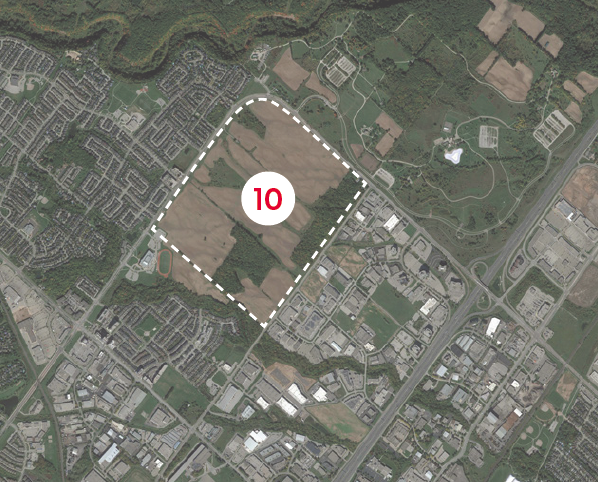 Bronte Meadows – designated Employment Lands, the owners, Paletta International, have been trying for years to have it zoned residential. It was part of a package of land in the GTA that was offered to Amazon when they were looking for a new HQ. • How much land supply is there to accommodate future long-term population and employment growth in the City?
• What are some of the recent broader macro-economic and regional growth trends which will influence growth in Burlington?
• What do the City’s recent economic, demographic and real estate trends tell us about future growth potential?
• What is the potential range of population and employment growth that the City can expect between now and 2041 based on available supply and market trends?
• Given the range of potential growth and multiple opportunities for development, what are the phasing considerations for residential and employment growth?
The analysis in this study relies on a number of different sources including components of the City’s adopted Official Plan, Halton Region Official Plan, the Growth Plan for the Greater Golden Horseshoe as well as provincial guidelines (e.g. MTO Transit Supporting Guidelines). Data related to the City’s active development applications and building permits was also relied upon to complete the analysis.
Adopted New Official Plan
The Dillon – Watson study recognizes the direction received by Council to undertake a scoped review of the building heights and densities contained within the adopted new Official Plan. The methodology used in the analysis builds upon the urban structure and intensification opportunities identified through the City’s growth framework in the adopted new Official Plan. However, building height permissions in the adopted new Official Plan were not used in the analysis. As such, any changes that result from the scoped re-examination of the adopted new Official Plan are anticipated to be within the supply scenarios tested.
 The Mobility Hubs are on a bit of a hold while the Planning department focuses on a number of critical studies that need to be completed before development can get back on track. Mobility Hub Work
The study also recognizes the work that has been undertaken to date on the Mobility Hubs. For the downtown, the Urban Growth Center boundary and density target established in the Growth Plan were used in the supply analysis, while the population and employment ratios were based on the detailed mobility hub work. Similarly, for the GO Station mobility hubs, two density targets were used in the supply analysis; one reflective of the density target identified in the adopted new Official Plan, while the other reflective of the density target established in the Growth Plan. The population and employment ratios used in the analysis were based on the mobility hub draft precinct plans.
Supply Analysis
A review of the City’s active development applications was completed to inform the analysis of the supply of land available for both residential and non-residential growth. These development applications represent a snap shot in time and reflect development applications ranging from those under review by City staff to those currently under construction.
The supply analysis completed as part of this study helped to understand how much additional growth the City could expect based on current policies and plans. A top-down approach was used to estimate supply by applying a density target (people and jobs/ha) along with population and employment ratios to different areas of the City to identify the full build out potential. However, for some areas of the City which are not anticipated to accommodate much of the new growth, a factor was applied to identify full build out potential.
Full build out is assumed to be post 2041 and represents a conceivable end state where land has been fully optimized.
All this takes place while development work in the downtown core is under a one year freeze that has about five months left before a recommendation comes back from the planners. The Interim Control Bylaw (ICBL) was deemed to be necessary when the city found it was overwhelmed with development applications.
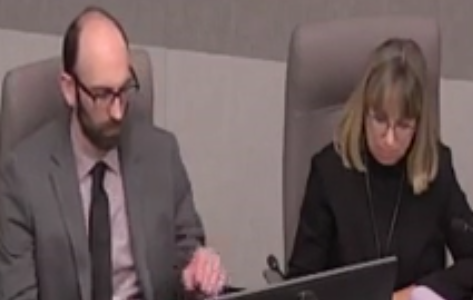 Planner Jamie Tellier and Director of Planning Heather MacDonald during a city council meeting. Planning Director Heather MacDonald was given the green light to single source the consultants she would use to put together the report. MacDonald has been a planner for at least two decades and she knows all the players in that game. She is firm on the report being in the hands of council within the one year time frame she was given; in our last conversation with MacDonald she made it very clear that meeting the delivery date was paramount – and she doesn’t appear to be one who scrimps on quality.
While the ICBL report is being researched and written the “Adopted Official Plan” is getting a very heavy duty re-write and re-think.
And while that re-write and re-think is taking place there is a group working on plans that attract as much public reaction, response, comment – anything anyone wants to say.
Mayor Meed Ward has made it the thickest of the pillars that hold up her election platform.
She wants to hear – she wants to listen.
The five new City Councillors are in for the hardest assignment they have ever been given. Some are faltering under the work load; some live on this kind of deep policy stuff.
There is a public that depends on the thinking they do and the wisdom they bring to the table.
After a decent summer break – they skipped a July Council meeting – they are now back in the trenches. In seven weeks they will celebrate being elected.
Two of the five (Nisan, Kearns) fought off contenders, one other (Stolte) was a certain winner once it was a clear one on one race with a long term incumbent, the other (Sharman) was an incumbent who won because two women let the vote be split. Another (Bentivegna) won by the slimmest of margins against a candidate who really didn’t run all that much of a campaign. The last newbie (Galbraith) came out on top of a very crowded field.
 Were the right choices made – can the team handle the amount of work they have been given? Time will tell. We will know in the not too distant future if the right choices were made.
There is no doubt that at the Mayoralty level the right choice was made given what was on offer. Only time will tell if the Mayor lives up to the promise.

 By Pepper Parr By Pepper Parr
September 3rd, 2019
BURLINGTON, ON
It will be a very full week.
On Monday, the 9th, Council starts off with a daylong meeting that has 8 consent items on the agenda.
Then details on the Provincial Audit and Accountability Fund, that’s the program that has the province coming in to help (tell?) the city how to run their operation.
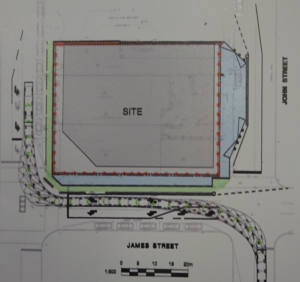 Detours that transit buses will take when The Gallery starts demolition and construction opposite city hall. 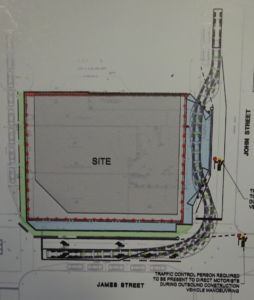 Cement and dump trucks will come down John Street, slip into the construction site and then leave via James street – passing buses along the way. The Standing Committee will be discussing Open air burning permit areas, a Stormwater management update, the badly needed Construction and Mobility Management Policy. The city got caught a little short-handed on this one; two projects that are expected to be putting up hoardings in the near future met with ward 2 residents and talked about how they would handle the trucks and the traffic on Brant Street opposite city hall and on Lakeshore at Martha. Both locations are going to be construction sites for the next 30 months – at the same time Lakeshore Road is to undergo some serious upgrades that will close it down for up to 8 weeks.
The Strategic Asset Management Policy is going to be discussed, and Consideration for free transit for students will also get discussed.
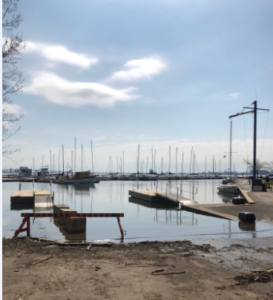 The LaSalle Marina just might end up with a very different governance model. Discussion will take place this week. Flooding has been a serious problem. The Marina governance and operating model will be presented – this item will take place in the evening – at 6:30 pm.
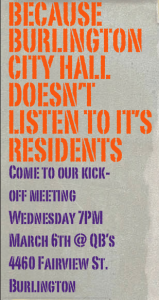 Improvements to the Skyway Arena and community centre are in the works. There was a time when citizens didn’t think they were being heard. They are today. Will they be heard when a decision gets made on the massive development plan yards away from the arena The New Skyway Community Centre will also be discussed during the evening of September 9th.
On Tuesday the 10th council meets as a Standing Committee – Planning and Development this time.
There will be two Statutory Public Meetings; these are public meetings held to present planning applications in a public forum as required by the Planning Act.
One is a rezoning application for the hydro corridor north of 1801 Walker’s Line which staff is recommending be refused.
The second is for an official plan amendment and rezoning application for 2085 Pine Street
Statutory public meeting and recommendation of refusal of rezoning application for the hydro corridor north of 1801 Walker’s Line (PB-16-19)
Both items will be discussed at 6:30 p.m.
The Heritage Burlington 2017/2018 annual report and 2019 objectives is being treated as a consent item.
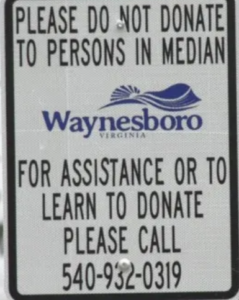 Several Council members liked what was being done in Waynesboro – they want staff to look into some better ideas. Traffic management strategies will be discussed at the 9:30am meeting along with Relocation of Bingo Connection and Downtown Streetscape Guidelines. Panhandling on streets in the City of Burlington is to be discussed – this matter often brings out emotional responses from those that delegate.
There will be a Staff direction regarding Airbnb’s and then the Red Tape Red Carpet Task Force recommendations.
This item amounts to much more than a discussion about the Task Force the Mayor set up to hear what stakeholders had to say about how efficient city hall was or wasn’t. Buried within the report is the wish of the Mayor to totally revise the way economic development is done in Burlington.
There will be an Amendment to Nuisance and Noise By-law 19-2003 and results from Halton Regional Police Service’s pilot project to stop noisy moving vehicles
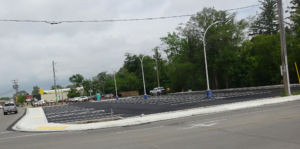 Council didn’t get a chance to opine on the construction of this parking lot at John and Caroline – it just got done. This Council wants greener parking lots. Green parking lot design guidelines for new parking lot at John and Caroline Streets and future builds. The 2018 – 2022 council has a very green agenda and were upset when the John and Caroline parking lot got opened without any serious consideration to making it a “green” space. Capital Works, the department that oversees and administrates the construction work for the city didn’t see that coming.
Wednesday is an Audit Committee meeting – dry as toast for the most part.
Thursday is a tough one. Members of Council were presented with a 152 page report on what the city is facing in terms of population growth and just where that intensification can or is going to take place.
That will be a special report later in the week.
Related news articles:
Pan handling
Construction site management
Skyway Arena and Community Centre

 By Pepper Parr By Pepper Parr
August 25th, 2019
BURLINGTON, ON
Exclusive to the Burlington Gazette. Part 1 of a 3 part series.
It was a decent crowd – even for a meeting that was poorly promoted.
The outcome wasn’t all that clear – what was evident was that the audience didn’t like what they heard and that PERL, Protect the Environment and Rural Lands, the people who fought and won the last battle for Mt Nemo, was not going to lead the charge this time around.
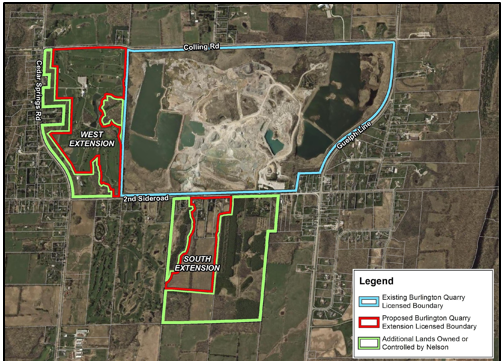 The current Nelson Aggregate holdings: They own the southern portion and have an option on the western portion. The green line is a property boundary; the red line is the extraction boundary. The operators of the quarry, Nelson Aggregates, had let it be known that they were preparing to make a revised application to mine for aggregate in the southern portion of the site and for the land to the west which is currently Burlington Springs Golf Club.
The Gazette met with the people speaking for the quarry operation and learned much more about the scope and scale of the new plans.
The quarry is owned by Lafarge, Canada’s largest provider of diversified construction materials and a member of the global group, LafargeHolcim. The company has 6,000 employees and 400 sites across Canada.
The operators were taken aback by the 2012 decision to not allow the application to mine on land immediately to the south of the existing quarry. The decision rested on the existence of the Jefferson Salamander that is a threatened species that habitats the area.
It was not an expected decision and resulted in a serious cut back in the number of people employed on the site.
 Walt Rickli, raising the belt on a hoist at the studio he once had on the quarry site. They needed the aggregate beneath his building – so he had to move. Walt Rickli who had a sculpture studio on the land had to find a new home for his heavy equipment – the quarry people needed every square foot of land they could get a back hoe into.
The Nelson quarry people studied the Joint Administrative Review Tribunal (JART) report and worked at how they could resolve the Jefferson Salamander problem and be able to mine the land.
They did their homework and will take their application to the Regional government, City of Burlington and the Niagara Escarpment Commission after which they have to seek a development permit. They will also be seeking a change in the zoning. Three different permits will be required plus a new license from the Ministry of Natural Resources and Forestry.
Mayor Marianne Meed Ward and the Director of Planning has said that before the city even looks at any application they want the decommission work done.
That statement, to some degree, came out of a little bit of ignorance. The license the quarry was given in the 70’s was to mine as much quarry as they wished, or could, on the clearly de-marked site.
The license the quarry has is unlimited, it does not have to be renewed but does require that the land be left as a “lake”.
The critical note attached to the license states:
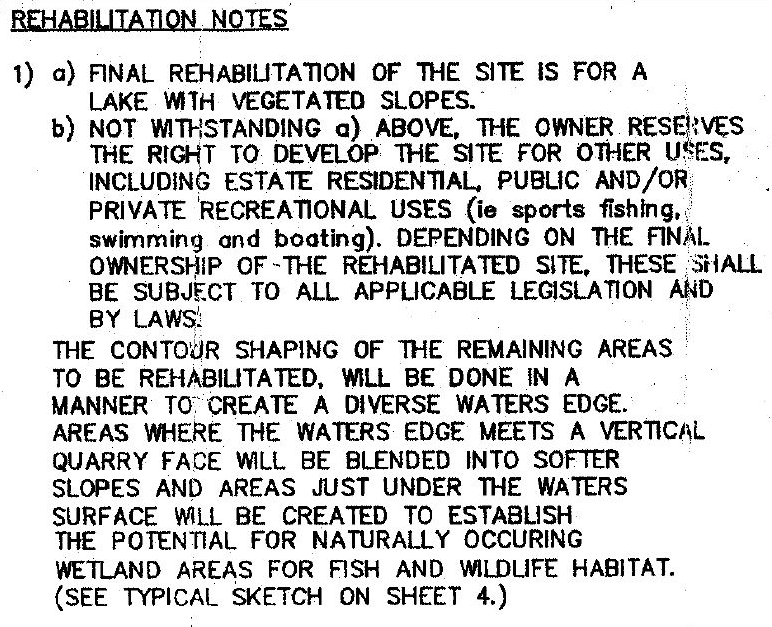 A note that is part of the license Nelson Aggregates has to mine the property on the #2 Side Road.  Land in the current quarry that has been rehabilitated. Nelson has already been very proactive in re-rehabilitating the land. When they are finished with one area they begin the rehabilitation. That work is clearly evident when you tour the property which the Gazette did last week.
Before any permit is issued Nelson is fully committed to a dialog with the community. They want to be sure that the residents in the rural area, and those south of Dundas, are fully aware of what the quarry is asking for and offering.
One has to fully understand the quarry’s position. They are in the business of mining and processing some of the best aggregate deposits in the province. They believe they have been good neighbours, which is not a view shared by some.
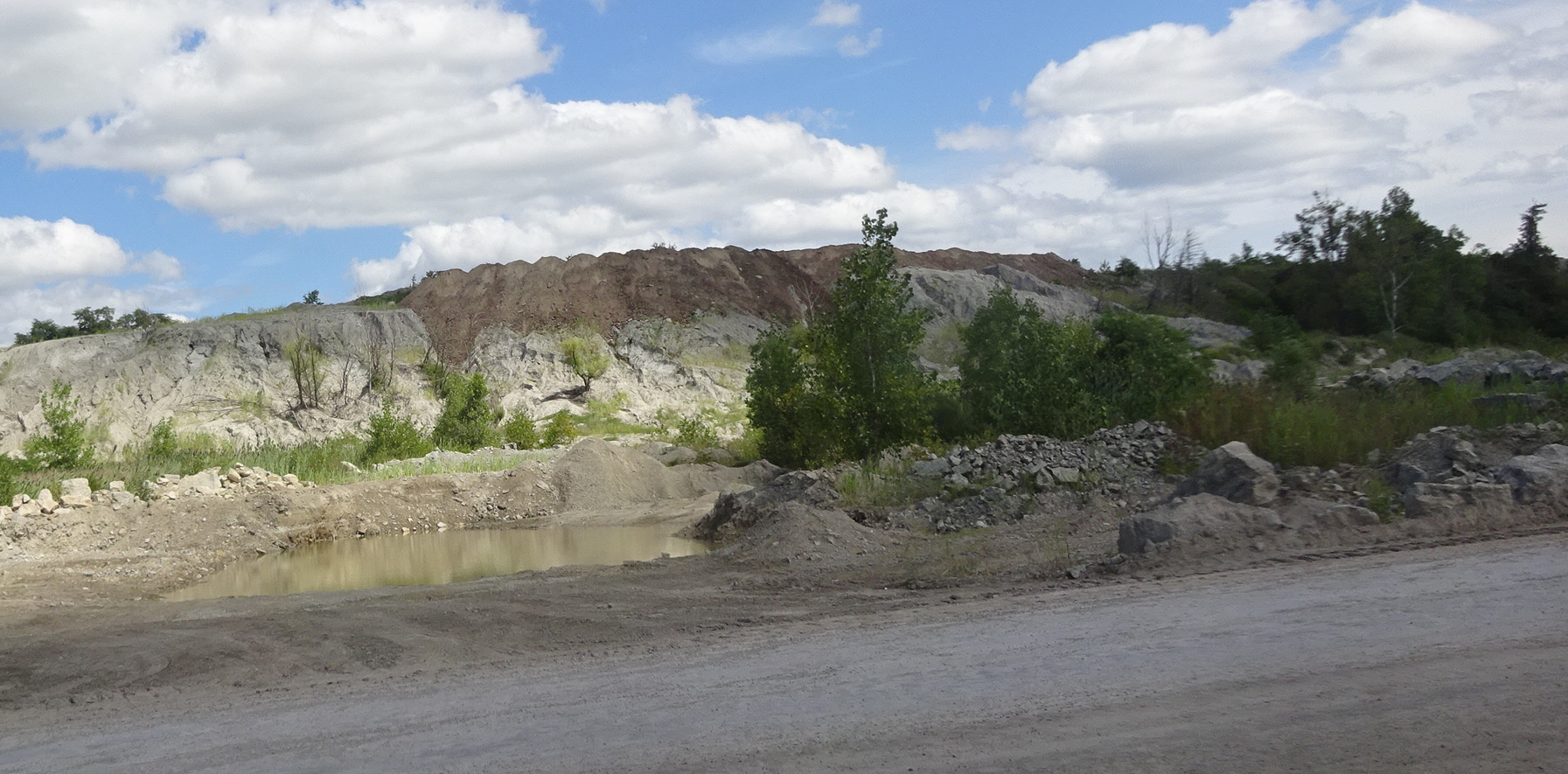 Rehabilitation of the existing quarry is an ongoing task. The dark brown in the center atop the hill is land fill that has been dumped in to the land. Residents in the past have complained about the damage done by dynamite blasting. The quarry is required to limit blasting to one day a week at a specific hour. They can only blast on Thursday’s between 12:00 and 1:00 pm. As they prepare to file their applications they will do the now obligatory pre-consultations to ensure that they are complying with all the regulations and learn what they have to provide in the way of studies to ensure that the public interest is being met.
Among the studies that will have to be completed are:
Planning / ARA Site Plans –MHBC
Hydrogeological Assessment – Azimuth
Surface Water/Water Balance Assessment – C.C. Tatham
Karst Assessment – D. Worthington
Fully Integrated Groundwater and Surface Water Model – EarthFX
Natural Environment Assessment – Savanta
Agricultural Impact Assessment – MHBC
Built Heritage Assessment – MHBC
Cultural Heritage Landscape Assessment – MHBC
Archeology – Golder
Traffic Study – Paradigm
Noise Assessment – HGC
Air Quality Assessment – BCX Environmental
Blasting Assessment – Explotech
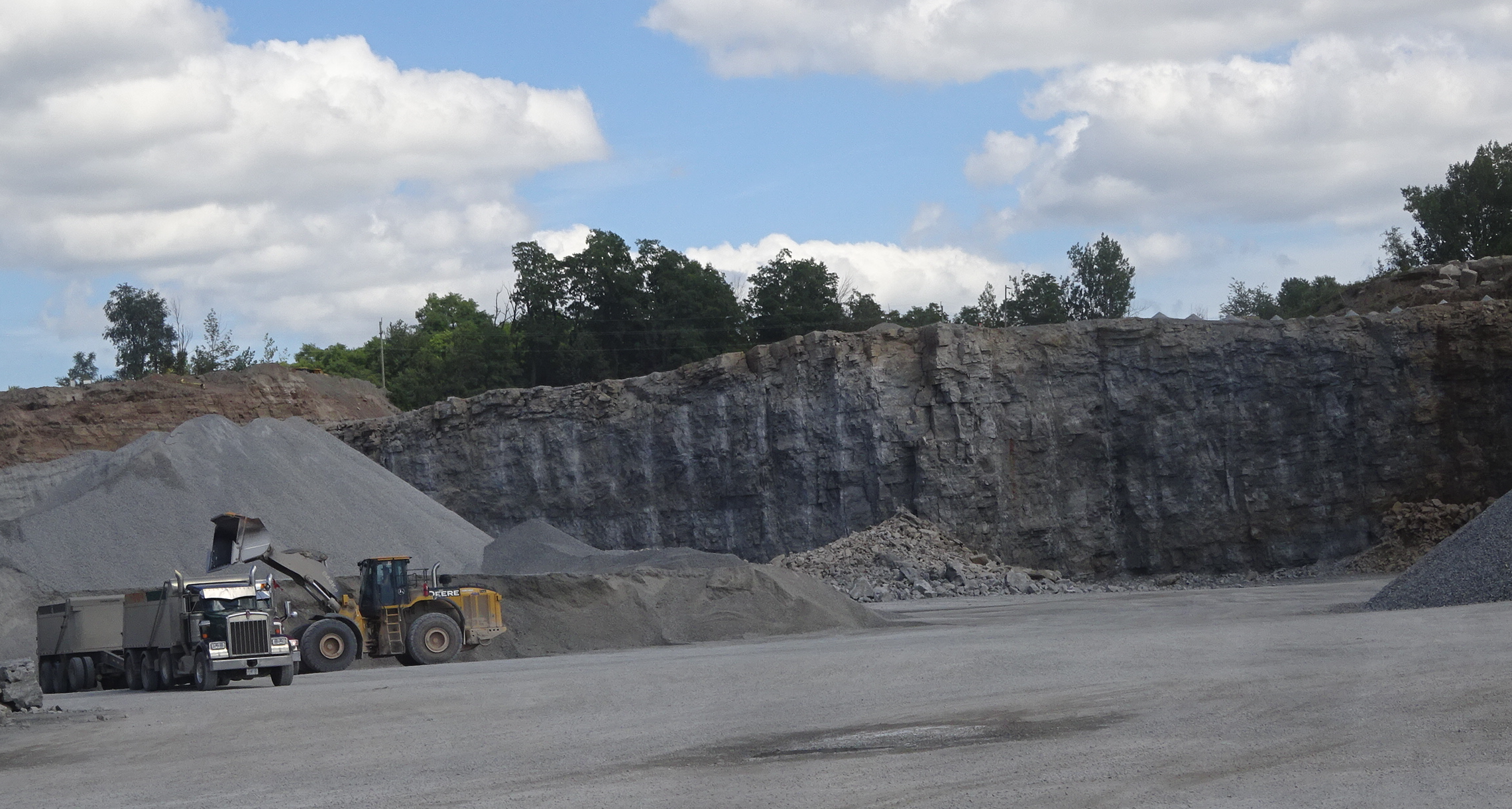 Aggregate is mined daily on the site. Mining for aggregate is a highly regulated business. The Nelson quarry pumps water out of the site that is some 80 feet below ground level. If those pumps break down they have to immediately advise the Ministry of Natural Resources and Forests and effect repairs as quickly as possible. In order to mine effectively it is vital to keep water out of the site. There are a number of catchment ponds around what is really a huge bowl that has been blasted out of the property from which aggregate has been taken.
Nelson Quarry is proposing that once they have completed the quarrying they will rehabilitate the land and turn title over to the city who will run it as a public park.
The Nelson people are going one further – they are going to create a 15 hectares lake that will have a large sandy beach. The shallow end of the lake (a little like Wasaga Beach where you can walk out for yards before the water comes up to your chest, will become a little deeper and then get quite deep..
In the application they have completed studies that show where the Jefferson Salamander lives and have undertaken to not only not mine that area but to turn it over to the city the day the agreements and zoning bylaws have been set.
The original 2004 application was on property south of #2 Side Road.
The application that will be submitted in the near future will consist of a 60% reduction in proposed extraction area from the previous application.
The revised extraction area will be designed to address the reason the Joint Board refused the previous application (Joint Board Decision 08-030 issued on October 11, 2012).
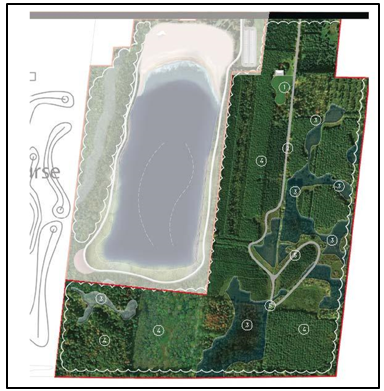 The area to the right was part of the 2004 application. It will be given to the city the day the agreements to permit quarry work has been signed. The area to the left will be turned into a lake for the public once it has been quarried out – which will be between 7 and 10 years. In the studies and research they have done the Nelson Quarry people point out that their land holdings meet all the requirements of both the Niagara Escarpment Commission and the Region of Halton.
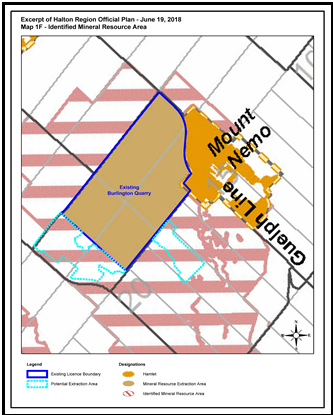 This illustration is from the Regional Official Plan – the area with the pink stripes is suitable for quarrying. The recently adopted City of Burlington Official Plan (April 2018) identifies the proposed extraction areas as an “Identified Mineral Resource Area.” The adopted city plan Nelson points to was submitted to the Region and returned to the city because it didn’t comply with the Region’s plan. Burlington is in the process of revising that adopted plan.
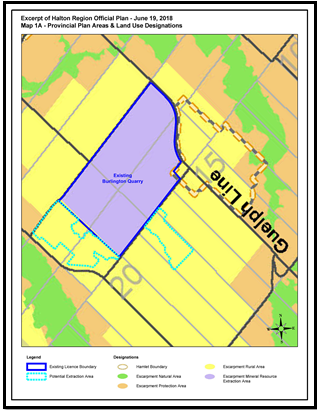 This illustration from the Niagara Escarpment Commission permits quarrying in the area shown in yellow. The portion of this are that Nelson wants to quarry is is shown in light blue. The sites are also mapped as a High Potential Mineral Resource Area in the Region of Halton Official Plan.
The existing Burlington Quarry represents Burlington’s only source of construction aggregate within the City.
There are three designations that apply to the land in the NEC plans: natural, protected and rural area. The Nelson properties have the designation that allows for consideration of new Mineral Resource Extraction Areas in the Niagara Escarpment Plan.
In the NEC plan the proposed extraction area is designated Escarpment Rural Area in the Niagara Escarpment Plan.
The appropriateness of this designation and objective was confirmed in the recently approved NEP (2017).
The Nelson Quarry people have done their homework and are returning with an application they feel meets all the shortcomings of the 2004 application that was decided in 2012.
They have significantly reduced the space they will mine on the south side of #2 Side Road and have added the 606 acres that make up the Burlington Springs Golf Course that will give the company enough aggregate to mine for the next 30 years after which it too will be turned over to the public.
 The lake that will be created on the south side of #2 Side Road Burlington is looking at the potential for a park that will be in the 900 + acres realm – bigger than anything most municipalities across the country have.
Nelson Aggregates will be holding an Open House on the quarry site in October and expects to have their applications in to the three levels of government sometime in November.
Just what will the park consist of? Tomorrow we will detail what we learned in our exclusive interview the people at Nelson Aggregates.

 By Pepper Parr By Pepper Parr
August 23, 2019
BURLINGTON, ON
Ooops!
A portion of a sentence was left off the paragraph about the pipeline that runs through the centre of the city that was mentioned in the story on the Construction Management procedures that will be in place for the building of the condominium opposite city hall.
In explaining the traffic congestion that was going to take place in the downtown core at the same time two high rise condominiums were to be built we left out the detail about remediation work being done to the pipeline that runs through the city – it carries fuel for aircraft at the Hamilton airport. No specific date on when that work will start.
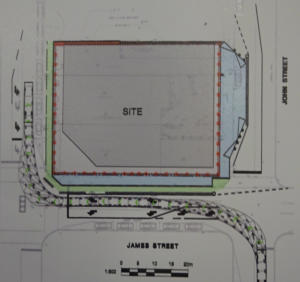 Transit traffic will come down Brant and swing onto James and then go south on John. 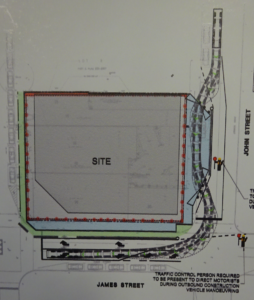 Cement and dump trucks will come south on John street, drive on to the site and then continue down John to Brant when they have off loaded The public was told that Lakeshore Road will close for a period of time while repair work on the surface is done.
Detail on what the flow of traffic would be during the 30 month construction period that The Gallery, the 23 story condominium that will be built opposite city hall, was released.
Cement trucks and dump trucks will compete with buses and private automobile for room on Brant, John and James Street.
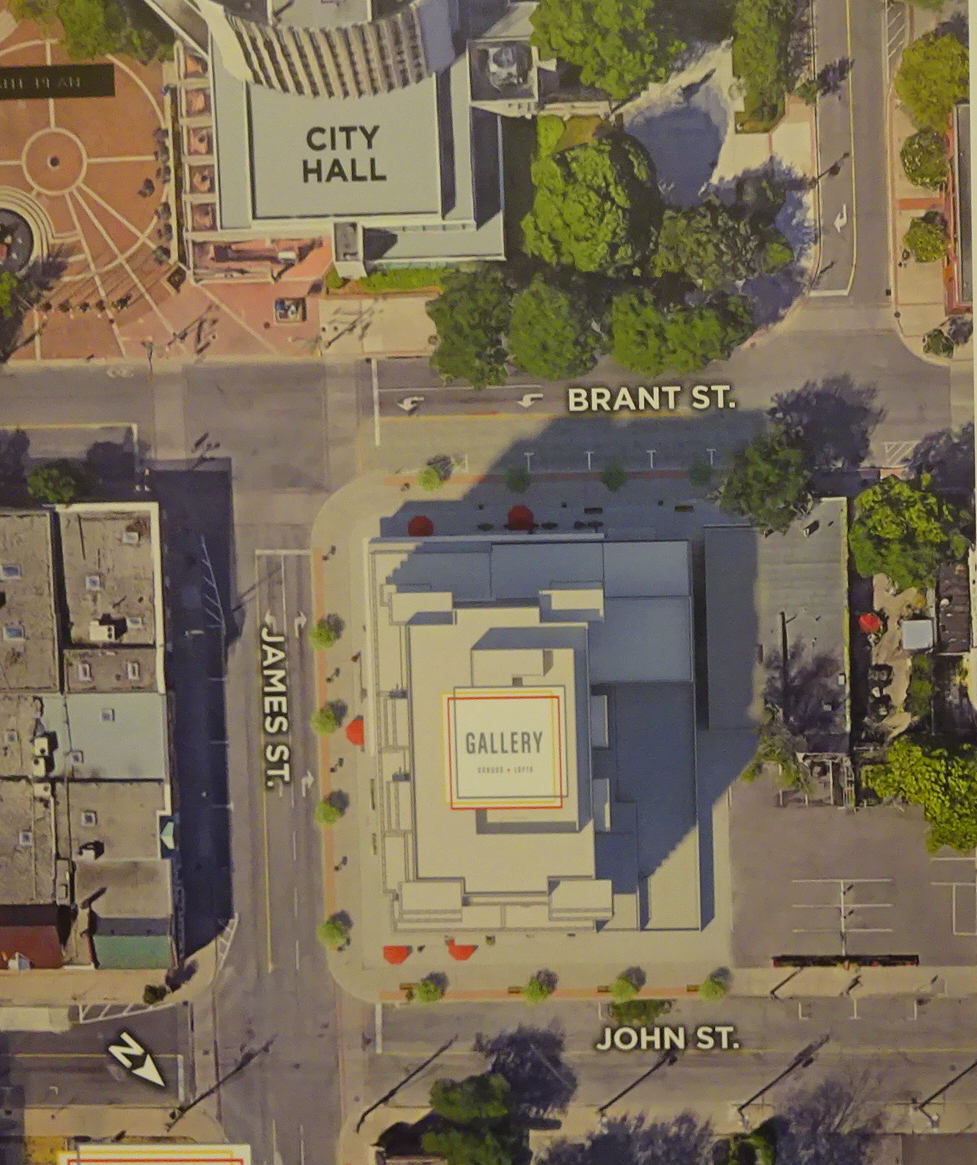 An aerial rendering of how the condominium will fit into the corner of Brant and James – with city hall across the street. It will be interesting to see how the Santa Claus parade winds its way through that part of the city in December.

 By Pepper Parr By Pepper Parr
August t 22nd, 2019
BURLINGTON, ON
 Lisa Kearns waiting for a question from the audience. Lisa Kearns, Councillor for ward 2 was back before her constituents again – it was the second week in a row that she stood before an audience and took them through the intricacies of Construction Management and Traffic control during construction projects..
Last week the meeting was related to the Adi Nautique development at the corner of Lakeshore and Marsha where the audience learned that the construction timeline is about 30 months.
This time it was the Carnacelli development opposite city hall – where the time line is 30 months. The 23 storey development, known commercially as The Gallery also has a new address – because the entrance is going to be on James they are using the municipal address of 2011 James to identify the development – not to confuse people who follow this type of thing.
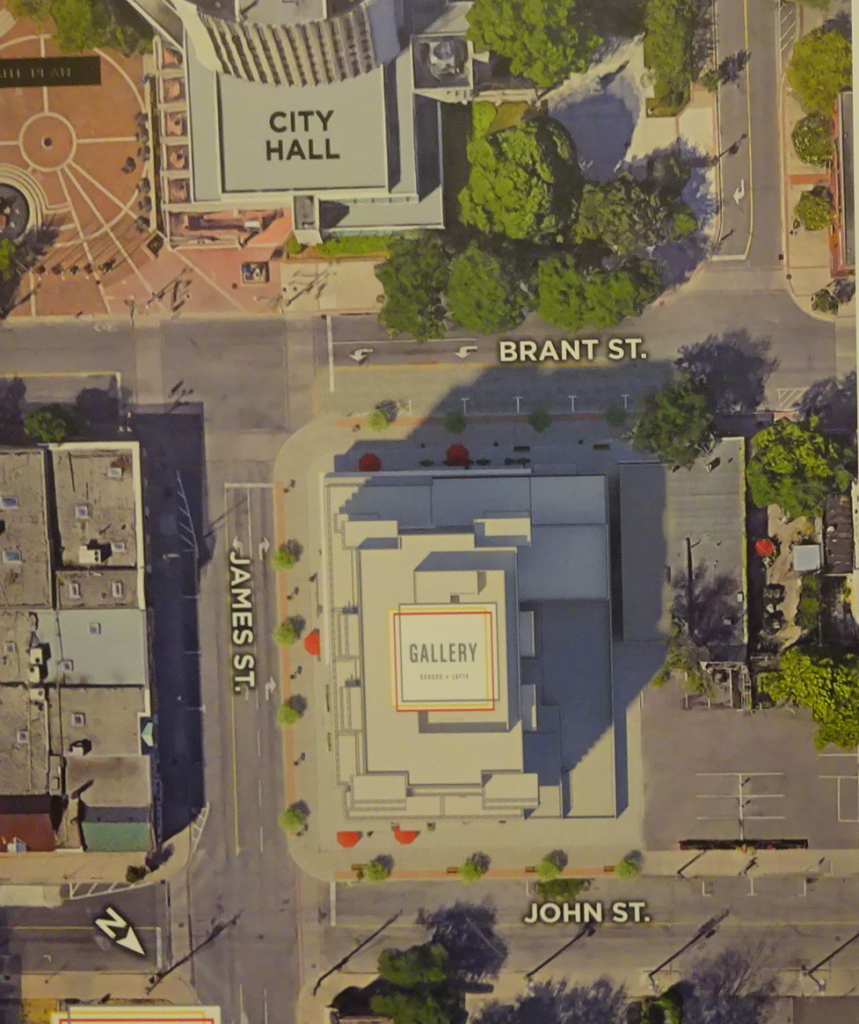 The property to the left of the site has been approved for 17 storeys – they have appealed asking for 23 stories to match The Gallery development. The Centro Garden is on the extreme right. The two developments are less than a km apart and will be under construction at about the same time.
Carriage Gate, the developers of the project, announced that they expect to begin demolition sometime immediately after Labour Day.
At about the same tine Lakeshore Road will be closed for a period of between eight and twelve weeks for road improvement work.
The audience was also advised that a pipeline that runs right through the city coming in from the Beachway along Elgin Street and running through the rear of the Mayrose Tayco property at the north end of the Elizabeth Street parking lot is scheduled to have some major remediation done – no specific dates were given.
Chaos is the word that best describes what is going to take place in the city.
The objective is to manage that chaos as professionally as possible. Kearns was in the room explain that everything was going to be fine – there were protocols and procedures in place to handle every situation.
Drawings were displayed showing where the trucks that will haul away the material from the demolished site and where the concrete trucks would be staged while they were waiting to enter the site, disgorge the concrete and move on so that the next truck could come in.
 Cement and dump truck movement plan.  Transit movement plan. The public will not lose the use of the Brant Street or James Street – the areas where construction is taking place will be covered so that pedestrians are safe.
Kearns assured the audience that she would be on top of it all – her office on the eighth floor of city hall overlooks the site.
Concern about the noise, the dust and the traffic flow were not as important as to where the trades people working on the site were going to park. The Carnacelli interests on the property the Berkeley was built on and the land to the north where there was to be a parking lot and a medical building that would front on Caroline – that space will be used for parking in the early stages. Mark Bales who is overseeing the project did announce that the corporation had arranged to rent about 40 parking spots from the city – which didn’t go down all that well with the area residents or those with retail operations in the immediate area.
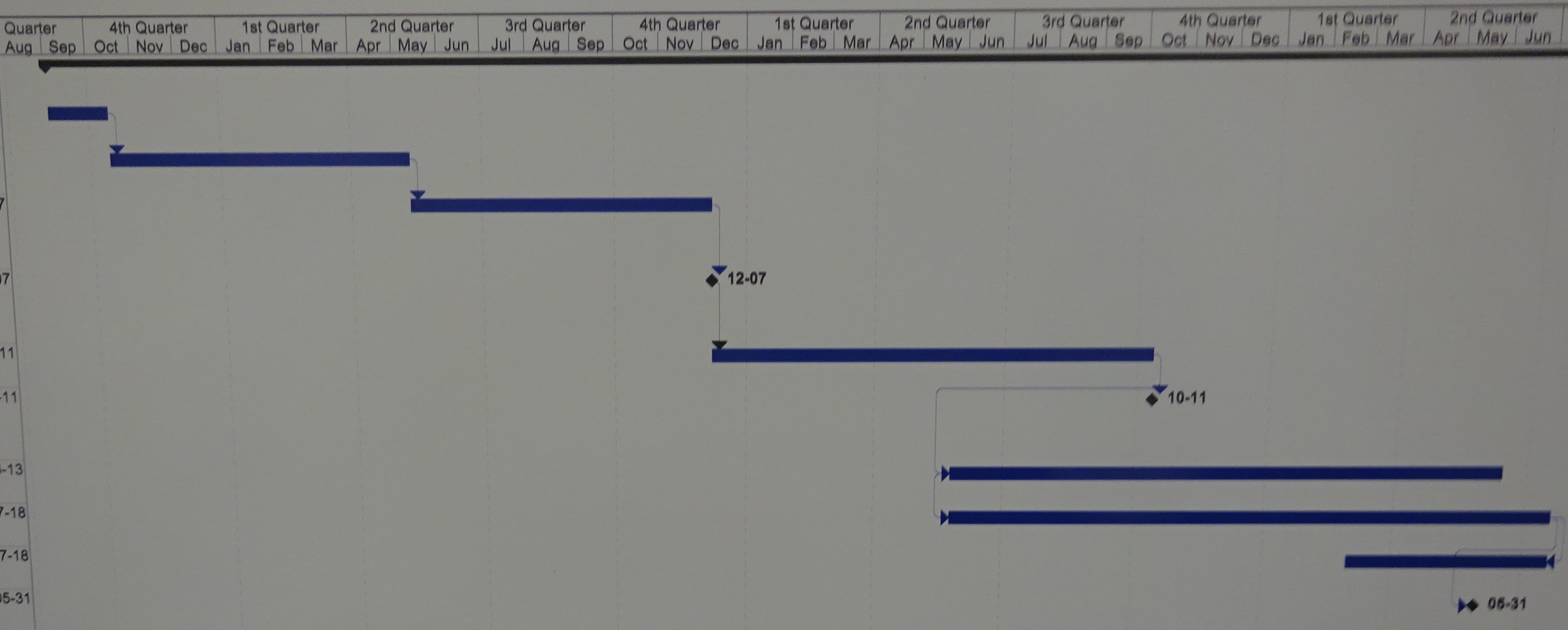 Timeline for the construction and completion of The Gallery opposite city hall. People wanted to know how many trucks would be in the area – they were told seven to nine which was later bumped up to 12. They will be driving in and out of the site from 7:00 am to 7:00 pm.
The audience was told that there could be anywhere between seven and seventy workers on the site at any one time.
Kearns has worked with Transportation department people and has, she said, gone as high as the City Manager to resolve some of the issues. The City is in the process of creating a Construction Management Plan that will be in place for future developments.
Kearns said that given the developments that are in line at the Planning department the city is looking at three, five perhaps even seven years of downtown construction.
There then came a point in the meeting when Kearns decided all the questions had been asked and answered and it was time to wrap it up.
The audience got the “bums rush” and those who had questions could hang around.

 By Staff By Staff
August 16th, 2019
BURLINGTON, ON
City hall is reminding people that there are public engagement opportunities now underway to help shape the adopted Official Plan policies that will guide development in the downtown core.
They want to know what matters most to you about downtown Burlington.
Their hope is that they (the planners) can work to gather public feedback about the downtown policies in Burlington’s adopted Official Plan. The process begins with a series of pop-up events. Additional public engagement opportunities to share ideas that will help refine and improve the downtown policies include two Citizen Action Labs taking place on Thursday, Aug. 22 and an online survey available at www.getinvolvedburlington.ca
All four buildings are within a five minute walk of each other. These are basically done deals with others in the planning stage. If this is what you want – say so – If this isn’t what you want speak up.
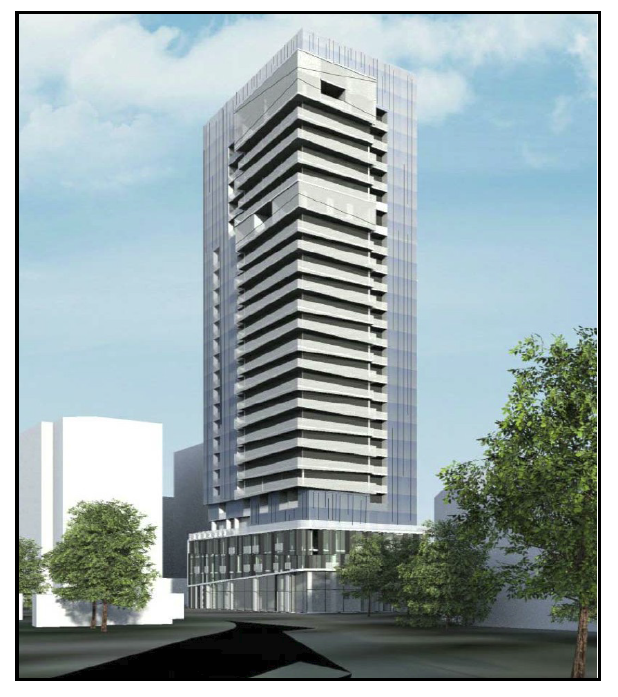 The Nautique – shovels will be in the ground within months and take close to three years to complete. 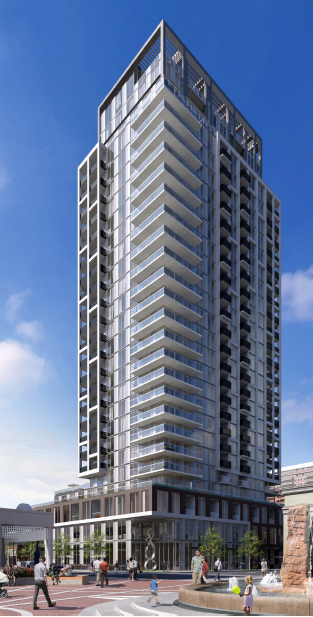 Due to go up across the street from city hall. 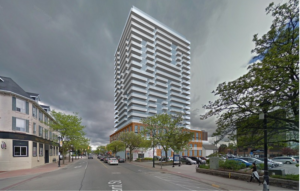 Approved for 17 floors – developer wants 26 – has appealed. To go up opposite city hall as well. 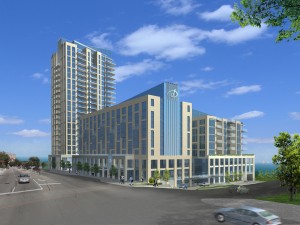 Completion has stalled – they need another year to complete the job. Pop up Events
City staff will be visiting a variety of locations and events throughout the community to talk with residents and identify what is most important to them about downtown Burlington. They really want to hear what the average person thinks. During the October municipal election people complained that city hall wasn’t listening. They are listening now. Let them hear what you have to say.
Pop-up Dates and Locations
Friday, Aug. 16 Burlington Farmer’s Market, 777 Guelph Line 9 a.m. to 1 p.m.
Saturday, Aug. 17 Spencer Smith Park (playground), 1400 Lakeshore Rd.
Tansley Woods Library, 1996 Itabashi Way
11 a.m. to 1 p.m. & 2 to 4 p.m.
Sunday, Aug. 18 Burlington Performing Arts Centre, 440 Locust St.
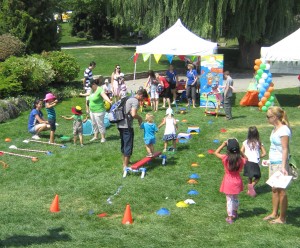 Children’s Festival will be taking place on the weekend – planners will be out in force asking for your opinion. Children’s Festival, Spencer Smith Park, 1400 Lakeshore Rd
Central Park (bandshell), 2299 New St.
11 a.m. to 12 p.m. & 7 to 7:30 p.m.
Monday, Aug. 19 Alton Library at Haber Community Centre, 3040 Tim Dobbie Dr.
5:30 to 7 p.m.
Tuesday, Aug. 20 Appleby Arena, 1201 Appleby Line
Brant Hills Library, 2255 Brant St.
12:30 to 2 p.m. & 6 to 8 p.m.
Wednesday, Aug. 21
Brant Hills Library, 2255 Brant St. 11:30 a.m. to 2:30 p.m.
Saturday, Aug. 24 Burlington Farmer’s Market, 777 Guelph Line
Aldershot Farmer’s Market, 484 Plains Rd. E. 8 a.m. to 2 p.m.
Citizen Action Labs – Taking a Closer Look at the Downtown
At these public meetings, participants will work in small groups to discuss and identify what is most important to them about downtown Burlington.
Thursday, Aug. 22
1 to 3 p.m. or 7 to 9 p.m.
Art Gallery of Burlington, 1333 Lakeshore Rd.
Online Survey
An online survey will be available until Aug. 30 at www.getinvolvedburlington.ca to share input about what matters most about downtown Burlington.
Feedback gathered from all the public engagement activities will be used to inform the creation of two concepts of what the downtown could look like in the future. These concepts will be shared with the public in the fall for review and further input.
Visit www.GetInvolvedBurlington.ca to learn more about the re-examination of the downtown policies in the adopted Official Plan and upcoming engagement opportunities.
 Not everyone sees the process city hall is using to gather feedback as the best there is. ECoB Engaged Citizens of Burlington, the group that organized the public debates in every ward that was to a considerable degree responsible for the changes at city council have written the planners with their concerns. Not everyone sees the process city hall is using to gather feedback as the best there is. ECoB Engaged Citizens of Burlington, the group that organized the public debates in every ward that was to a considerable degree responsible for the changes at city council have written the planners with their concerns.
1. The Feedback summary of comment and advice received during the pre-engagement process includes a broadly fair summary of comments provided by ECoB during our meeting with the planning department.
2. Our impression in meeting with the Planning Department staff was of a good faith intention to carry out a better engagement process during the Official Plan Review than has been made in the past. ECoB welcomes the growing recognition of effective and genuine engagement in city decision-making processes. ECoB welcomes the opportunity to take part.
3. ‘Doing engagement right’ is a difficult, time-consuming and potentially costly process. It is important to recognize at the outset that the extremely restricted timescales will of necessity create an imperfect engagement process. While the OP Review provides an opportunity for limited additional input from residents over what was received in the initial ‘Grow Bold’ process, it will still be far short of what we would consider the ideal engagement process for a new Official Plan. We believe it is better to recognize these shortcomings now than to argue that a comprehensive engagement process can be carried out in the time available. This observation may be valuable in future engagement initiatives and the ongoing review of advisory committees and engagement in general.
4. The feedback received has been made anonymous in the summary sent to us. We believe it would in fact be advantageous to know which comments came from which groups and individuals. Purely as an example, one can guess that the stipulation that the Engagement Charter be referenced frequently came from the ChAT team. Likewise, there was contrasting advice on ‘pop-up’ engagement processes. Knowing who gave this advice might clarify why there is a discrepancy in opinion. The source of advice is highly relevant in assessing the value of feedback received, and for those attempting to understand how the engagement plan was formed. We believe there is no reason why the names and affiliations of all people consulted could not be included, in the interests of openness and transparency.
5. The pre-engagement process primarily involved receiving advice from advisory committees of various sorts. Only two organizations (ECoB and the Hamilton-Halton Home Builders Assoc.) are fully independent of City Hall. It would further clarify to know who, if any individuals were consulted and to ascertain their independence. ECoB’s position is that the current make-up and selection processes for advisory committees is in urgent need for reform, as recommended by the Shape Burlington Report in 2010, but not implemented. Ironically, most advisory committees, including ChAT, do not regularly interact with the public. There is a perception of a lack of transparency in the selection of citizen volunteers and the operations of the ChAT group. With the greatest of respect for the volunteers on the committees, some of whom are also ECoB members, these longstanding procedural problems weaken the validity of advice received.
6. Having consulted with our members and executive over the last week, there is certainly still concern among our membership that the engagement process will remain too superficial. As we stated during our meeting, we strongly encourage the planning department to ‘be bold’ with the engagement that it conducts to go beyond conventional methods. This should include acknowledgement of and clearly stated attempts to reach:
◦ People from all age groups. Meetings with school-age children a year or so from adulthood are easy and quick to arrange through civics classes and may provide a different but important perspective. The same goes for seniors groups (albeit seniors are traditionally well represented in ‘volunteered feedback’), but also commuters and young families. ‘Pop- up’ events may be most valuable if held, for instance, at ice-rinks or venues where young families take children to participate in sport, as well as malls and supermarkets.
◦ People of different ethnicities. Reaching out to local religious and cultural organizations can be an easy way to ensure people of different ethnic and cultural backgrounds are included.
◦ People of different income groups. Again, religious organizations and local and regional non-profits can advise on the many events and gatherings organized for people on low incomes.
Unless attempts to meet and address these groups are explicitly mentioned in the engagement plan, they are highly likely to be overlooked.
7. We mentioned during our meeting, but it is not included in the summary, the possibility of using local organizations to help with engagement. This would need to be done in a way such that the volunteer groups could not influence the information collected. Such groups could assist with delivery and collection of questionnaires, or explaining the engagement process to people who would traditionally not participate.
8. We did not mention at our meeting but would like to add the suggestion of an important education component to assist residents with learning about the planning process. A fear of a lack of knowledge is a major barrier to people participating in engagement activities. Such a program was provided for new councillors in 2018 – it could be adapted for the public. While the most frequently engaged residents become aware of the complexity of the issues at hand, other residents are naturally less well-informed. This can lead to unrealistic impressions of what is feasible in the provincial and regional planning context and to repetitive and time consuming covering of the same ground. This is where a prominent educational component, presented as separate educational meetings, plus a website and/or documentation, would be of value to both planning staffs and citizens.
9. Re: “Trade-offs and options – Avoid oversimplifying discussion to height alone”
By contrast lack of background information or education must not invalidate resident opinions. This phrase copied above embodies some of the problems that frequently arise when institutions undertake engagement. It is imperative that when questions are asked of residents, they are not asked in ways that lead to institutionally-desired responses. An example of such a ‘trade-off’ question is: “Would you be willing to accept additional height in return for a medical facility included in a development”. Height is a huge issue for many residents, and that opinion has to be recognised and acknowledged alongside all others, regardless of how problematic it is marry that desire with the current provincial planning context.
“Maintaining low-rise to mid-rise character”, or “lower heights in downtown”, are perfectly valid desires for a residents to have, and residents should neither be patronized to by an inference that they “don’t understand”, nor should their opinions be hidden by using engagement processes which lead to minimizing widely held opinions.
In summary – it is the purpose of engagement to find out what residents and other ‘stakeholders’ want, and then to see how the OP Review can best satisfy those desires within the context of the in force provincial and regional planning frameworks. It is not the job of engagement to shape opinion in ways which may appear more convenient.
10. Some of the most ‘scientifically’ valid and innovative methods of engagement available are being ruled out by time and budget. While time is certainly an issue, we would urge the City to consider an increased budget if it allows engagement at a scale, and of a validity, that has not been achieved before. The key objective must be to reach a representative sample of the vast majority of residents who, for entirely valid reasons, do not take participate in conventional engagement opportunities. We feel dollars spent at this stage will save expenses and points of conflict at a later date if an OP is put together that residents can broadly support.
Conclusion
The summary of pre-engagement gives a reasonable reflection of the advice we provided at our meeting with the Planning Department, and we have noted some items which we think could have been included. We do have concerns that some of the same processes which failed citizens in previous OP engagement efforts are likely to be repeated. Nevertheless, we believe the Planning Department is moving in a better direction with regard to engagement. Cognizant of the shortcomings of previous engagement exercises, we would like to see additional weight given to engagement methods by which “the city goes out to residents ”and not “residents coming to the city” thereby reaching out in as representative a manner as a manner as possible to the entire population.
While the timelines are extremely short, we still believe the City should set ambitious engagement objectives. If doing so demands additional budget, we believe the City Manager and Council should make the funds available urgently to ‘do engagement right’.

 By Pepper Parr By Pepper Parr
August 15th, 2019
BURLINGTON, ON
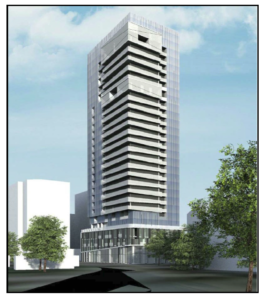 It was a surprisingly good crowd for a meeting that was about Construction Management for a building that is far from popular. It was a surprisingly good crowd for a meeting that was about Construction Management for a building that is far from popular.
There were at least 75 city residents in the room along with perhaps ten from the ADI Development Group and three – maybe four from the city.
They were on hand to learn what the Construction Management program for the build of the 26 storey Nautique at the corner of Martha and Lakeshore Road was going to look like.
It wasn’t a pretty picture.
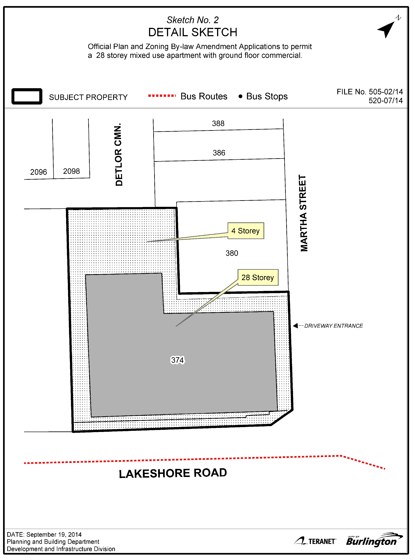 The site is at a part of Lakeshore Road where the lanes narrow. Staging equipment and managing the trucks that will arrive almost by the hour is a herculean management task. The site is at a part of Lakeshore Road where the lanes narrow. Staging equipment and managing the trucks that will arrive almost by the hour is a herculean management task.
The public didn’t like much of what they heard but city transportation staff explained that they were up against a site that was always going to be difficult to work with.
The development had been approved via an appeal to the Ontario Municipal Board (OMB) – the developer had first appealed the city’s failure to process the application within the required amount of time.
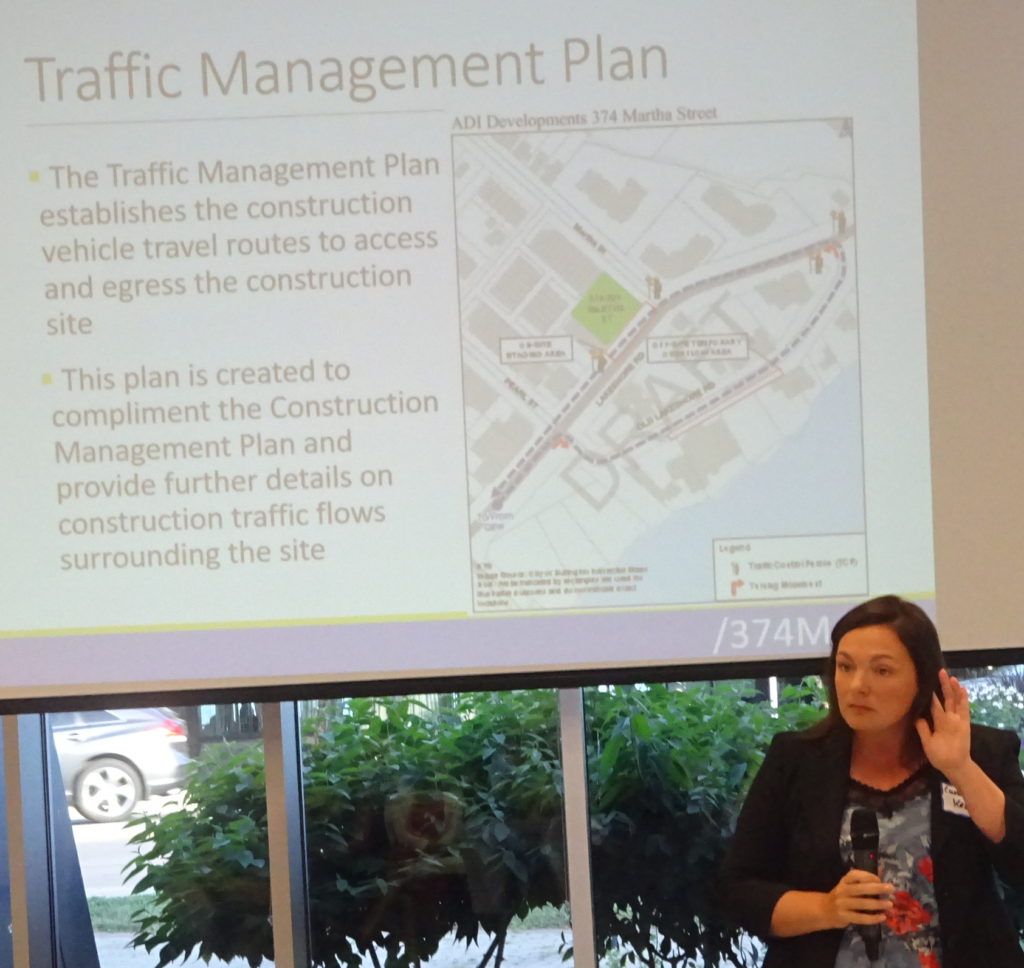 Ward 2 Councillor Lisa Kearns listening to a question The meeting was hosted by the ward Councillor, Lisa Kearns who had planned on having the people who were going to do the construction and the city staff who were going to oversee the work speak to the issues.
Kearns had said earlier that she didn’t want the event to be a Q&A where the same questions were asked over and over.
Try as she might – Kearns got a full-fledged Q&A – there were not only a lot of questions – some answers – but some very good suggestions from the audience. She commented that it looked like they were about to “wander into the worst case scenario”. It wasn’t that bad.
Street access and parking, noise and dust control and – ‘will the ambulance be able to get to my door?’ were amongst the questions.
Kearns wanted to assure people that the ambulance would get there – Martha’s Landing, a retirement home is across the street from the development.
Greg Sage, chief of the Paramedic services was on hand to assure everyone that the ambulances would get through although he didn’t say that his people would be working with the traffic managers that ADI was going to have on site.
 Albert Facenda listening intently  Josie Wagstaffe submitting a comment. 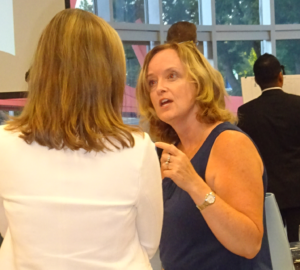 Lynn Crosby bending the Mayor’s ear. Parking for the construction workers didn’t get resolved as nicely. The city recently opened 60 spaces in the addition to the parking lot behind Joe Dogs on Brant Street – ADI has arranged to rent 40 0f them. “We just got those parking spaces” was a comment from the audience.
It was suggested that the workers be given parking spots some distance away where they would not take parking away from people shopping in the downtown core and then use a shuttle bus to get the trades people to the site. An approach like this was used by the hospital when it was being built. The ADI people didn’t seem to be impressed by that idea.
Traffic flow – it is going to be miserable. There will be no left turn off Martha onto Lakeshore. Lakeshore will narrow a bit right in front of the site.
One of the pluses was the three flagmen that ADI will have on the site.
Staging of trucks delivering material to the site will be on OLD Lakeshore Road; the flagmen will get them off Old Lakeshore and onto Lakeshore.
 Some of the ADI Group staff were on hand to explain what they were doing. Construction will take place from 7:00 am to 7:00 pm and on some occasions, especially when concrete is being poured they will work into the night – requiring special permission to do so.
Both the Councillor, the Mayor and the people from the transportation department said, on several occasions, that meetings to talk about construction management were something new for the city. ‘Never been done before’ said the Mayor and the Councillor.
Not true – when Monarch was building in the Headon Forest community they held meetings with the residents on a monthly basis.
Kearns did her best to convince the audience that she “was their champion” and that she ensured there were “course corrections” when they were needed.
She explained that she was at the table with the Transportation people pushing for the interests of the area residents. “You will know what is happening and I will be here to lead you through this.”
The audience was told that the construction was going to take 30 months and that the Bridgewater development was another year away from completion. The two site are a couple of football fields apart.
No one asked why the building was going to have seven storeys of underground parking rather than the six that has been approved. One has to feel sorry for anyone who has to wind up seven levels to get to the street. It is a very small site.
The meeting also learned that next week, in the same location – at the Art Gallery, the Carriage Gate people will be on hand to explain how they are going to manage the development of their site – opposite city hall – where demolition of the existing buildings is planned for some time in September.
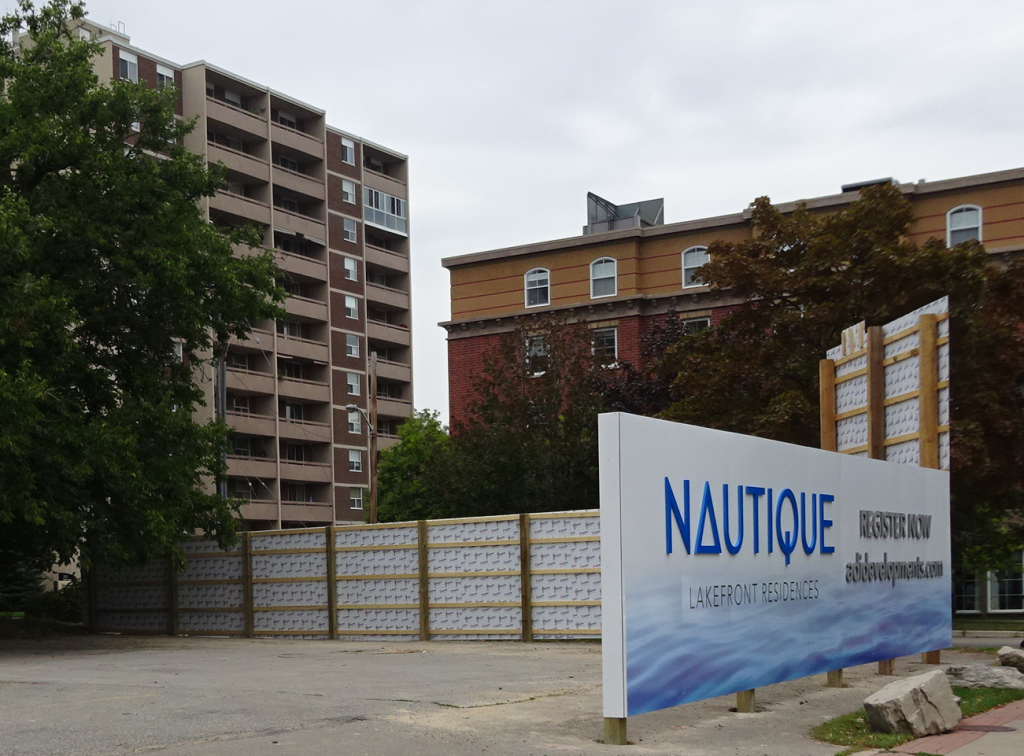 It is not a very big construction site. Cranes on the Burlington skyline.
 The Adi brothers. The issue on the problems that will crop up and how they will be managed will depend to a very large degree on how the ADI people respond and behave. They are a tough crowd, they know what they want to do and they don’t let very much get in the way.
The buildings they put up are well designed – they have brought some very progressive looking buildings to the city and word is that the quality is there.
Hopefully the corporate attitude has been toned down.

 By Pepper Parr By Pepper Parr
August 14th, 2019
BURLINGTON, ON
There was nothing unusual about the meeting that was called for people to hear what the ADI Group wanted to say about their next step on the controversial development to be located on the south west corner of Martha and Lakeshore Road.
 The Nautique – the ADI Group flagship development. Approval to build the 26 storey tower was given by the Ontario Municipal Board over the objections of the city. That approval was seen as the beginning of a process that has approved two other high rise towers and looks as if there could be as many as three others in the downtown core.
Eight months ago the ADI crew was drilling on the site to learn just where the water table was. Further down than many thought which has brought about a request for an additional level of underground parking.
One area resident told the Gazette that “It has come to our attention that ADI is requesting 7 levels of underground parking. The public was led to believe that it would be 6 levels. We questioned the wisdom of allowing 6 levels of underground parking so close to the Lake and now 7 levels are being asked for. It is difficult to believe that this will not cause any problems. The OMB appeal that the city lost, as far as I am aware did not grant 7 levels of underground parking so why is the city even considering this?
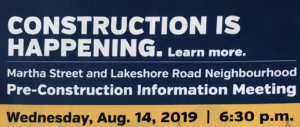 “We were also told that those living on Martha Street should drive along Pine Street and then access Lakeshore by using Pearl Street. This is a disaster waiting to happen. Presently it is often difficult to exit our condo garage with traffic coming along Pearl Street. The Pearl and Pine Retirement Residence often has large delivery trucks parked in front, or their 14 passenger van, as well as ambulances and medical transport vehicles. That area is used to pick up and drop off residents daily. “We were also told that those living on Martha Street should drive along Pine Street and then access Lakeshore by using Pearl Street. This is a disaster waiting to happen. Presently it is often difficult to exit our condo garage with traffic coming along Pearl Street. The Pearl and Pine Retirement Residence often has large delivery trucks parked in front, or their 14 passenger van, as well as ambulances and medical transport vehicles. That area is used to pick up and drop off residents daily.
“ Pine Street and Pearl Street are very narrow with on street parking and “sharrows”. Perhaps this is not the route that should be suggested, or at the very least remove the on street parking which will cause owners of businesses in the” live and work units” to become angry, and rightly so.
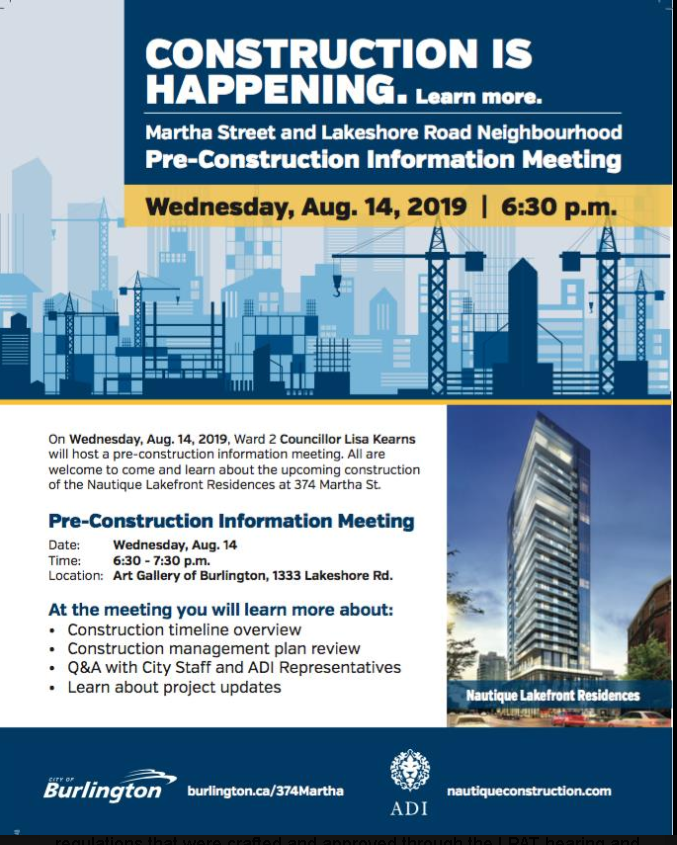 Many wondered why the announcement was a joint venture from the ward Councillor, the city and the developer. The public has not seen public announcements like this previously. “It has been determined by staff that the “staging” cannot be on Martha Street, and this will happen on Lakeshore Road. Presently the eastbound lane on Lakeshore has been narrowed to accommodate the construction of The Bridgewater which is years behind in completion, now the westbound lane in the same area will be narrowed? Trucks waiting for fill will line up on Old Lakeshore Road, I have to question if the owners of the businesses on that street have been informed?
“Where will the construction workers park? In the public lots that are already filled to capacity? Perhaps ADI needs to contract space for their employees at the Burlington Centre with a shuttle to take them back and forth.”
Comments like that suggest that it is going to be a noisy meeting.
Then we learned that the meeting is scheduled from 6:30 to 7:30 pm at the Art Gallery. These meetings are usually scheduled for at least two hours. Why the short time frame?
The ward 2 Councillor seems to have gotten herself quite excited about the development. In her Construction is Happening announcement makes it sound like a major social event.
She is scheduled to appear on Cogeco TV’s news broadcast Tuesday evening.

 By Staff By Staff
August 13th, 2019
BURLINGTON, ON
Our friends across the Bay in Hamilton have published a newsletter that has to be shared.
Citizens at City Hall (CATCH) comment on Bill 108 and the degree to which it is going to gut the way planners within municipalities have to deal with development applications.
CATCH said:
Additional though still incomplete information has come from the province about massive changes being made to rules on planning, community benefit agreements, parkland funding and development charges. Described as “welfare for developers”, the More Homes, More Choice Act appears to mean more subsidies from property taxpayers and an abandonment of the claim that growth pays for itself.
 The good citizens of Hamilton have looked at Bill 108 -and they don’t like what they see. The view will be the same from this side of the Bay. The stated objective of the legislation is to lower housing costs. It eliminates growth fees for services such as libraries, recreational facilities, parkland development and social housing. These make up about a quarter of the development charges currently collected in Hamilton from developers to offset some of the costs of new growth.
Some of these revenue losses could be recovered with modified Community Benefits Charges that are included in the legislation. These replace existing “section 37” collections whereby cities bargain with developers who want to exceed approved building sizes and densities and in return obtain various community benefits.
But the modified community benefits charge will be capped by the province at a rate that has still not been released so there is no certainty that the financial result will be equivalent to that obtained by the existing two growth funding mechanisms. And if a city utilizes this community benefits charge it will be forced to abandon collection of parkland dedication fees – a long-standing method of ensuring sufficient land for parks.
Currently the parkland dedication fee – which has been in effect since the early 1970s – requires developers to provide land or monies based on the number of new residents in the growth area. Now it will be set irrespective of how dense the development.
Toronto staff have calculated that for one new apartment tower the new rules will mean an 80 percent drop in parkland paid by the developer. In another situation, the park area falls from nearly four square metres per resident down to half a square metre.
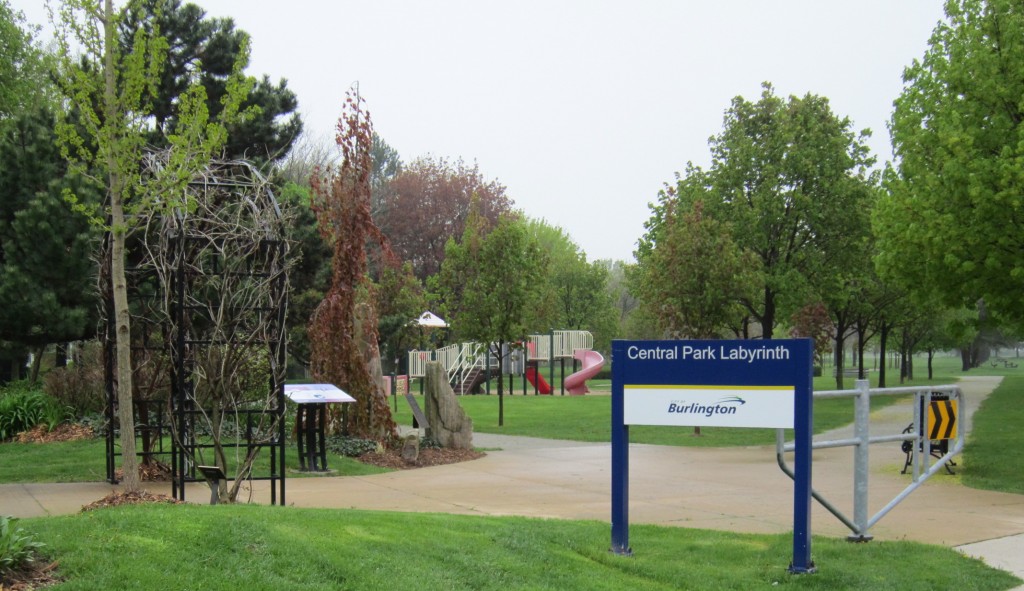 Developers will finance the same amount of parkland for a 48-storey building as for a four-storey one. This flies in the face of both provincial and local commitments to encourage higher densities, especially along major transit lines like the LRT. Instead the municipality will be penalized for more concentrated residential development and the developers will finance the same amount of parkland for a 48-storey building as for a four-storey one.
Other changes in the legislation drastically shorten the time allocated to cities to respond to development proposals. For example, the timelines for an official plan amendment drop from 210 days to 120. Local planners contend these make proper review and public consultation virtually impossible and will mean many more appeals to the provincial planning tribunal.
All of these changes are likely to leave existing taxpayers shouldering more of the costs of growth. As Hamilton’s chief planner Steve Robichaud warned in June: “There’s a big shift in terms of who pays for growth and how that balances and they’ve taken the costs off the developer and they’re shifting some of those costs onto the municipality.”
While the new rules are purported to lower housing costs, they don’t include any way to ensure this. “It is unlikely that they will positively impact housing affordability,” argue Toronto planners, “as Bill 108 does not provide for any mechanisms to ensure that reduced development costs are passed through to future home buyers and renters.”
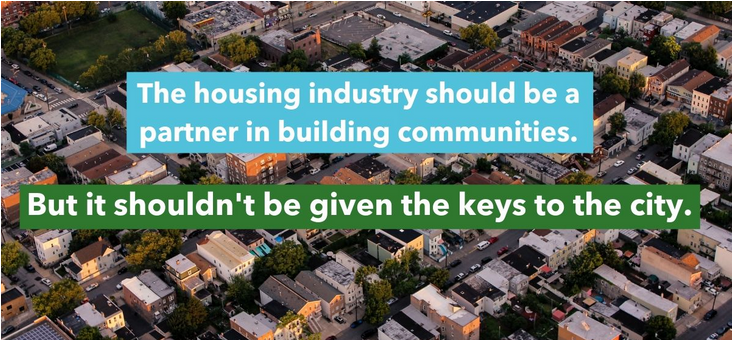 The developers may have been given even more than the keys to the city. The Ford government rushed through the legislation without details between May 1 and June 6, leaving municipalities scrambling to even provide comments on changes that could not be properly evaluated. Now Queen’s Park has extended the confusion with incomplete draft regulations and schedules.
“The province has not posted an actual draft regulation, but rather has posted a notice of intent to issue a regulation”, notes Hamilton staff.
“The regulations … have been provided in general terms and the full impact of the proposal is not capable of being fully understood and assessed without the official language that will appear as written in the regulation.”

 By Pepper Parr By Pepper Parr
August 12th, 2019
BURLINGTON, ON
OPINION
Earlier today the Gazette published an article on some problems that were brought to the public’s attention by Blair Smith and Lynn Crosby.
The problems they discovered after an exhaustive analysis of the data that was submitted to the City Clerk by each candidate brought some very disturbing matters to the surface.
Small administrative errors and typos happen. But when significant amounts of data just don’t appear a full public understanding of who contributed what to whom is no longer possible.
What makes the democratic system we have the success it is – is that we all abide by the laws in place and everything is transparent.
If the numbers aren’t available transparency isn’t possible. And once those who set out to game the system become aware that they can hide where their campaign election money came from, just imagine what can happen.
In a series that will follow in the Gazette in the weeks ahead we list who got what from whom and do our best to identify known developer interests.
Does receiving campaign funds from a developer mean that a candidate has compromised themselves – no but – know that developers are in business and they use their money to enhance their business interests.
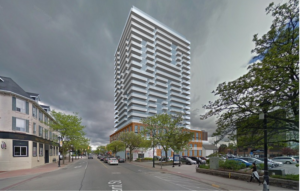 Two of the four buildings are done deals – two are working their way through the approval process. Did election campaign funding make them possible? 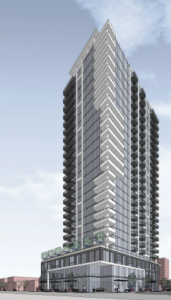 Done deal  Done deal 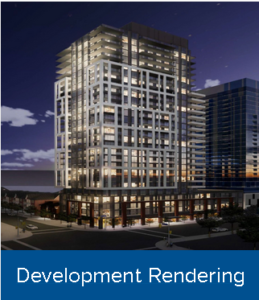 Looking for approval. The public depends upon the bureaucracy to protect their interests, to ensure that the data they get has been fully reviewed and meets the criteria.
How Mike Wallace got away with filing a return that did not have critical dates in his report is not just an oversight. It is sloppy administration done by people who don’t understand or appreciate that accuracy is important.
Are the results of the election in question? No.
The vote count was pretty decisive. The Office of Mayor was not won by money – it was won by a person who heard and responded to the cries of the people who pay attention to civic matters.
The disappointment is that less than 40% of the people who had the right to vote actually cast a ballot.
Mayor Meed Ward was not as unequivocal as she could have been on this matter; she has certainly had her issues with the way this Clerk has handled a number of matters in the past.
The comments made by the Clerk that this was a learning experience cannot be accepted. The position of Clerk in municipalities is significant; for example a bylaw is not in force until both the Mayor and the Clerk sign the document.
Smith and Crosby argue that the Clerk’s behaviour is “a completely unacceptable contravention of information practice and protocol, particularly for one entrusted with maintaining the integrity of the official record.”
It is up to Tim Commisso, City manager to decide what to do next, if anything. What he decides to do will say a lot about the kind of City Manager he is going to be.
There was a situation a number of years ago when the then Director of Planning, Bruce Krushelnicki, sitting at the Council table, advised council that a very senior member of his staff would no longer be in the employment of the city. He walked the individual back to his office; that was the last we saw of him.
Strong managers take strong action when it is necessary, providing they have just reasons for doing so.
Related news story:
Clerk revises public record – considered a no no.
Salt with Pepper is the musings, reflections and opinions of the publisher of the Burlington Gazette, an online newspaper that was formed in 2010 and is a member of the National Newsmedia Council.

 By Pepper Parr By Pepper Parr
August 9th, 2019
BURLINGTON, ON
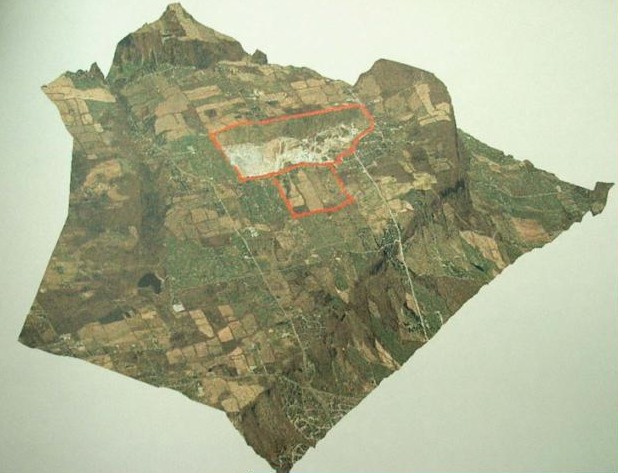 The top block in orange is the current quarry – the smaller orange block is where they want to expand. In 2014 their application was denied. Nelson has come back with a different approach. The good people of North Burlington, those from ward 3 in particular, met last night at the Conservation Halton offices to hear what their ward Councillor, Rory Nisan, could tell them about the plans Nelson Quarry has for the quarry that is close to mined out.
In a separate new story, the Gazette reports on what took place at a meeting that was basically Standing Room only event
While the Nelson Quarry people have yet to make an application – and thus there isn’t much the city can react to – the company has been active. They have a web site in place with a lot of pretty drawings and a considerable amount of detail on what they plan to do.
They have engaged two lobbying firms that are amongst the best in the business, to help in creating the story they want to be in the public’s mind as this project works its way forward.
Project Advocacy Inc. is Canada’s only public affairs firm that specializes in supporting project developers facing community opposition and government challenges.
Here is what they do: They take an innovative approach based on citizen advocacy.
“We use grassroots strategies combined with government and stakeholder relations to earn and maintain the social licence required for a project’s success. “
“We help developers find, organize and give voice to otherwise silent supporters of your project in host communities.
“Our sophisticated campaign strategies help identify local citizens supportive of your proposal and help organize them into an effective political force. They sign petitions. They show up at public hearings, and they act as local advocates for your project.
“This approach, paired with government and stakeholder relations, has proven key to getting large developments approved in Canada’s increasingly challenging licensing and regulatory environment.
“Whether it is an energy and infrastructure project, a mine, or a commercial real estate proposal, Project Advocacy Inc. will build an effective advocacy program that will counter NIMBY opposition and drive support for your project among local citizens, elected leaders, government officials and the media.”
Project Advocacy had their man in the room last night.
Motivated and sophisticated best describes the Project Advocacy group. They are supported by colleagues who are just as good at a slightly different level. Barry Campbell, founder of Campbell Strategies sets out the role that lobbyists play.
Pay attention to what this man has to say – he is very good at what he does. He was once elected to Parliament and has practiced law with two of the major firms on Bay Street.
 Barry Campbell, founder of Campbell Strategies “At Campbell Strategies, we have two types of clients”, explains Campbell: “those who have issues they need resolved. And, those who have opportunities they need realized. Despite this difference, there remains a constant between them. The need for wise counsel from people who understand their unique situations. Completely.
“As a bonus, our clients find themselves working with a team of government relations and communications professionals who are not only highly experienced, but without the hyperbole and self-importance that – in our industry – so often comes with it.
“We’re connected, of course. But it’s deeper than that.
“We treat our network of government, media, and regulatory leaders as relationships, not just connections. Our reputation is based on the right ask, at the right time, of the right people, with the right message.
“You’ll get no bullshit from us, and we’ll deliver none to our network
Campbell explains: “Lobbying at its best is vital to the flow of information and ideas. It bridges a significant gap between the public sector and the private sector and can lead to more informed public policy decisions and better corporate decision making.
“Lobbying is often attacked by the left as a way for powerful voices to “have their way with government”. Lately, the attack is coming from the right where libertarian voices have suggested that if government would only get out of the way (read deregulate everything), companies wouldn’t need to lobby anyone for favours. Both attacks are predictable and wrongheaded.
“There are many examples where information provided to officials seeking to regulate this or that has resulted in more effective regulation. Without lobbying, officials and elected officials would only know what they knew when they got to the office and I would suggest that is very often not enough of a baseline for serious decisions. That’s why officials consult and take meetings.
“When I was an MP, some wondered why I would ever meet with lobbyists. The answer was self-evident. If I never met anyone, I wouldn’t know anything other than what I already knew, which often wasn’t enough to help me understand complex issues. The strict lobby registration rules in Canada which require registration of most interactions with important public officials and provide a public record of same, are a pretty good check on what some worry about. The strict constraints and low permitted financial contribution rules are another check on the influence many worry about.
“And lobbying can be a public good or accomplish much public good.
 Tandia, an area credit union can now offer service that are basically the same as a bank. They lobbied to get the changes. “Lobbying can result in better and appropriately targeted tax or regulatory policy that achieves important public policy goals while removing the risk of collateral damage. A public policy goal to eliminate a practice believed to be adversely impacting consumers, such as pay day lending, might initially paint too broad a brush ensnare legitimate players who want to play by a coherent set of rules that don’t blow up their business model. Lobbying by credit unions resulted in changes to the Bank Act so that credit unions could expand nationally and provide more competition at the retail level. Lobbying by financial institutions and emerging ‘fintechs’ will shape a better financial services sector offering the choice that consumers want.
“As officials think about public policy and ready recommendations to “take to the Minister”, they are informed by the consultations with and entreaties by corporate and other stakeholders. That is a good thing.
“I have been a “lobbyist” for two decades and have never had a meeting with a Minister where he or she made a decision, then and there, to do something just because I asked. And I would never have that meeting (and it usually isn’t even ever required) without working first with the relevant departmental officials to do the tough slogging respectful of the job officials have to do to provide their bosses with the best and most informed advice.
“I know, and the best lobbyists know, that effective lobbying isn’t about setting up a meeting with someone important. That the easy part. Effective lobbying requires the right ask, at the right time to the right audience. It is research based and considers how the ask can dovetail with the government’s priorities by solving a problem or making my client’s problem a problem government comes to understand they need to solve because by doing so they will accomplish a goal they have.
“The problem can’t ever be putting relevant and contextual information in front of officials and decision makers. What they do with that information is their responsibility. To constrain the flow of information, between the public sector and the private sector and to close the door on that vital exchange will isolate public policy decision makers and inevitably lead to poorer decisions.”
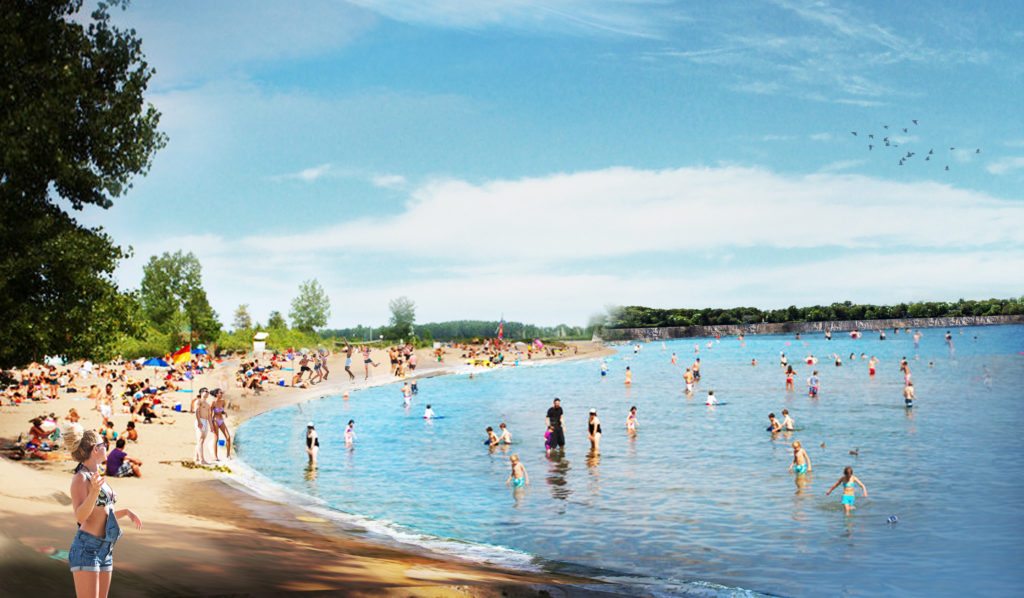 Nelson has released drawings of what they maintain the quarry could look like if turned into a park. This is what the people of North Burlington are up against. These are smart people who have been engaged by clients with a problem. Nelson Quarry needs the aggregate – it is there right underneath the surface and they believe they can convince the public that giving them access to that aggregate in exchange for parkland will work.
During the Thursday evening meeting there were a number of people who stood to speak – were they speaking for themselves or representing the interests of the lobbyist?
The first attempt by Nelson Quarry to get access to more aggregate failed. It started in 2004 and ended with a decision in 2012 that denied their application.
PEARL, a community organization formed to fight the application has basically disbanded. They fought the good fight and won. They are tired, they raised and spent a lot of money. The City of Burlington spent more than $2 million in legal fees.
But in the end the public will prevailed.
It will be a tougher fight this time around.
Background links:
Nelson quarry opens the park project web site.
The PERL web site

 By Pepper Parr By Pepper Parr
August 6th, 2019
BURLINGTON, ON
This is a seven part series on transit and how Burlington plans to get to the point where the public will take public transit to get to where they want to go in the city because it is cheaper, faster, more convenient and seen as the smart thing to do.
Part 6
Partnerships is going to have to be a large part of what the transit people do going forward. All the stakeholders have to be at the table which includes people who don’t see themselves as transit stakeholders.
Transit in Burlington has been trying for some time to create partnerships with the larger employers – looking for ways to create transit services that meet the needs of employees working shifts that were outside traditional working hours.
Nothing seemed to get any traction.
Strategy 4E: Employer Partnerships
 Fearmans was an excellent prospect for a partnership with transit. No one was able to make it work. Targeting employees that regularly commute represents a good opportunity to increase ridership on Burlington Transit. Employers that have standard office hours are typically located along key arterial corridors that have direct service, with start and end times that typically coincide with peak transit frequencies. Since service levels are high, the strategy for office employees is typically to target communications and marketing of the service and work with employers to offer an emergency ride home program if midday or evening service levels are not attractive.
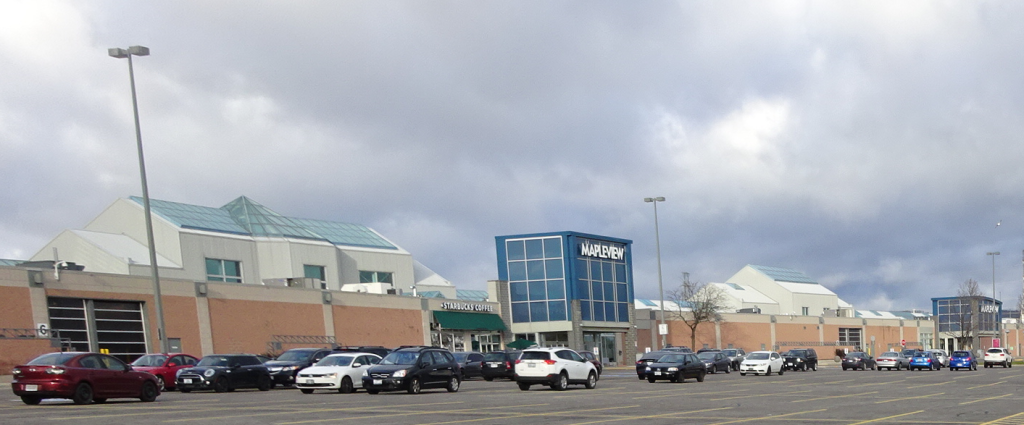 Mapleview parking lots are the size of a couple of football fields. The sales staff might consider public transit if they knew it was going to be reliable. Expect the Director of Transit to begin looking into that opportunity. Large industrial-warehousing employers, retail service employers and other employers located in areas not well serviced by Burlington Transit provide another employer partnership opportunity. These types of opportunities typically involve some degree of employer funding to provide more tailored service to meet employee requirements. This could include free or discounted transit passes, emergency ride home programs, and/or shuttle or on-demand services from transit hubs to work locations.
Burlington Transit staff time would be required to develop these programs and establish partnership with key employers. It is recommended that Burlington Transit staff first target a key employment area (e.g. the industrial area along Harvester Road) prior to developing a city-wide employer strategy.
This initiative aligns with Burlington Transit’s Strategic Direction #3 (Be Business-Minded and aligned with municipal directions), particularly Objective 3.2 (Partnerships), by working with employers to generate mutually beneficial outcomes.
Recommendations:
• Explore opportunities for partnerships with employers and evaluate alternative service delivery models to provide service to employees (Strategy 2A). Target one employment area first for a year to assess level of effort relative to uptake and ridership growth.
• Look at whether regular service can be supplemented by on-demand alternatives during off-peak travel times and/or emergency ride home programs (see Strategy 2A and 2B).
• In the longer term, explore an Employee Pass Program that offers discounts on transit passes based on enrollment in the program.
Strategy 4G: Improve Coordination with Other City Departments
Transit’s biggest asset is the land use and community design it operates in. Transit services that operate along mixed-use high density corridors with good connectivity to the places where people live, work and play offer the highest potential to grow ridership. In this way, transit and land use development are inexorably linked and therefore land use planning should always give strong consideration to transit needs, and vice versa. Ensuring the alignment of land use and transit will help create sustainable, mixed-use communities and also drive ridership by placing transit where residents and employees are located.
The City of Burlington has a number of plans to intensify around key transit corridors and mobility hubs. This is primarily focussed around the Burlington and Appleby GO Stations and the downtown terminal. In addition, the City of Burlington Official Plan (2018) identifies several corridors for mixed-use development and increased intensification. These include Brant Street south of Highway 407, the Plains Road and Fairview Street corridor and Appleby Line. The City is also currently conducting an Interim Control Bylaw review to assess the appropriate density and land use around downtown Burlington, the Burlington GO Station and the section of Brant Street connecting these two nodes.
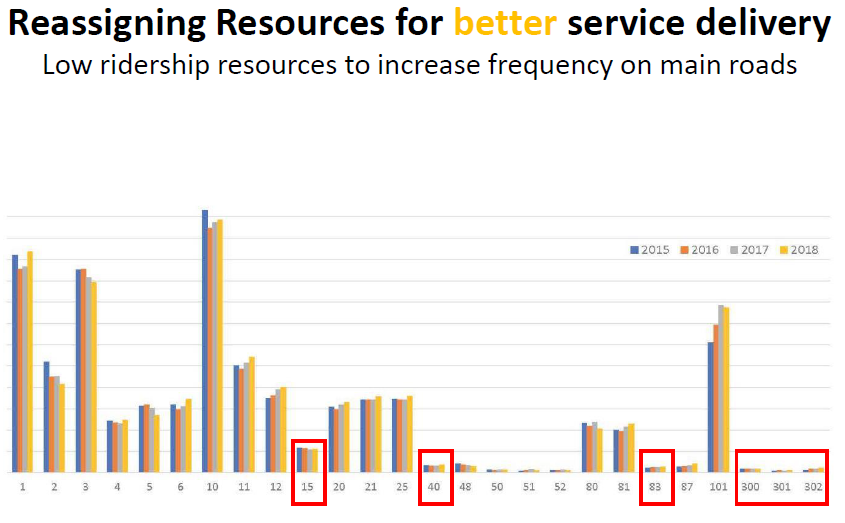 When you have a service pattern with routes that under perform the way several do – change is in the wind. Burlington Transit’s growth should largely be focussed on these corridors, which aligns with the arterial focus of Strategy 1A. As recognized in Strategy 1A, access between transit stops and this increased development will be key to ensuring that the potential transit ridership growth is achieved.
While improved planning integration between land use, roadway planning and transit is unlikely to result in measurable ridership growth in the short-term, it will pay dividends as development patterns evolve over time.
Improved integration with land use planning is the core of Burlington Transit’s Strategic Direction #2 (Be Forward-Thinking in how services are planned and delivered), particularly Objective 2.6 (Transit Oriented Development), as it facilitates better planning and delivery of transit services.
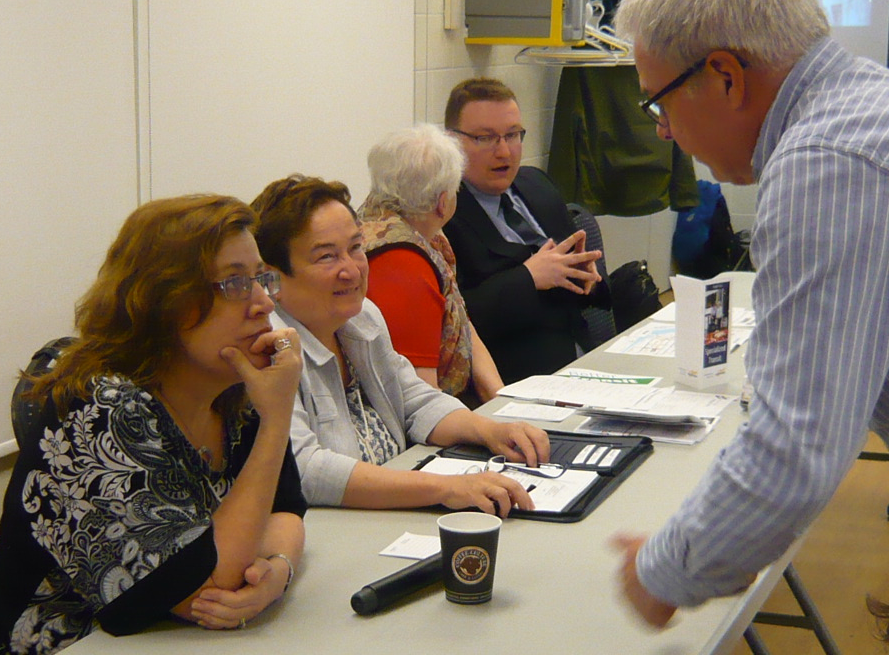 Sue Connor should be at every table when transportation and land use is being discussed. Recommendations:
• Play an active role in strategic land-use planning decisions, highlighting the need for high levels of pedestrian amenity and access to the arterial grid network.
• Continue to work with City of Burlington staff on the alignment of development, growth and employment areas with transit investment and service by reviewing development applications and secondary plans.
• Develop and formalize a Service Development Plan for Burlington Transit that outlines where service investment is expected in the future. This should be a living document that can help inform land use planning decisions to support transit.
• Develop a proximity service standard with the City of Burlington’s Planning and Development Department. This standard should define a five-year target from proximity to transit once the grid-network has been established and place to bonus on the Planning and Development Department to achieve the target based on growth.
• Continue to work with Transportation Services Department to coordinate transit interests in roadway capital improvement programs (e.g. new stops, shelters, accessibility improvements, transit priority features).
• Work with Transportation Services Department as a key stakeholder in the Integrated Mobility Master Plan and identify strategies to help meet the transit mode share target.
Burlington Transit has the best leadership it has had in a decade. Its leadership is far superior to that of the departments it has to work with to pull all the parts together.
The city manager appears to have gotten the message – assuming he has – there should be some heads banged together if that is what it takes them to work together – or let some of those heads roll.
Part 1: Transits five year plan has what some might call an over abundance-of wishful thinking
Part 2: Strategies and recommendations to create the needed structure and delivery model.
Part 3: Making all the parts fit.
Part 4: Can the public afford the new ideas?
Part 5 – Managing and influencing demand

 BY Pepper Parr BY Pepper Parr
August 5th, 2019
BURLINGTON, ON
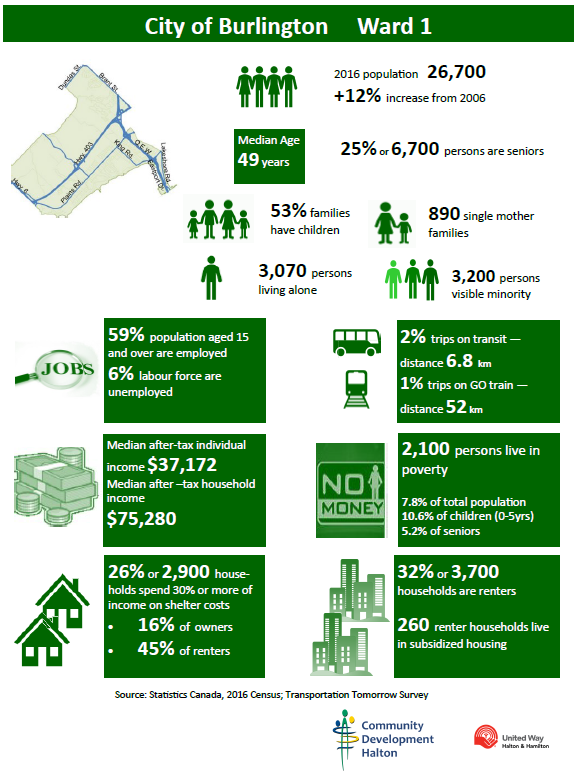 Community Development Halton has been in the news frequently this last month. Community Development Halton has been in the news frequently this last month.
Joey Edwards, the Executive Director for the past two decades, announced that she will retire in the fall. The Board has been actively developing the direction the organization will take in the years ahead.
A Gazette reader set out what he thought CDH needed to focus on as they revive an organization that has lost its focus.
Go onto Community Development Halton’s website and the one obvious thing that is lacking is a current statement of their Mission, Vision and Values. Virtually every organization today has this prominently displayed on their home page. CDH lists a lot of activities, but there is no easily accessible statement attesting to what they stand for, how they do it and their unique value proposition. I eventually found something called “Independent Community Based Planning in the Voluntary Sector”, but it was buried well into their website.
The second item that needs to be addressed is their name. Sorry, but “Community Development Halton” is amorphous and ill-defined. Develop what, and for whom? Looking at their website most of what they purportedly provide is social planning. Interesting research, but frankly not hugely impactful for a lot of residents, and most don’t connect with how this betters or improves their personal situation.
Another issue that needs to be addressed is their mandate. CDH’s website is laden with words like “facilitate”, “coordinate”, “partner”, etc. That does not describe an action oriented mandate or agenda. If you want broad-based community support, funding and engagement you need to be leading, directing and implementing. The not-for-profit community is strewn with all sorts of think tanks and research based agencies. Interesting from strictly an academic point of view, but not hugely impactful.
CDH operates with a 1990’s mindset, but that isn’t going to carry them very far into the future. The purpose statement on their website from the Social Planning Network of Ontario was written in 1994. The organization needs to re-position itself for changing times or else it will quickly fade into obscurity.
Recently CDH produced a profile of each of the six wards in the city – they sent the information to the ward Councillors but neglected to send the material to media – there is some solid data in those profiles.
The Gazette will be doing series on each ward and including that data. To give you a sense as to just how rich that data set is – look at what they have produced for ward 1.

 By Pepper Parr By Pepper Parr
August 5th, 2019
BURLINGTON, ON
The City wants to engage residents on the development of a citywide Private Tree Bylaw. The pilot project, which is currently underway within the Roseland community, will be reviewed.
Public sessions will be held throughout the city with the goal of informing and gathering feedback on the potential implementation of a Private Tree Bylaw citywide.
Earlier in the year, two information sessions were held to discuss the Pilot Private Tree Bylaw within the Roseland community.
An online survey is available at getinvolvedburlington.ca/privatetree until August 26, 2019 for those unable to come to one of the information sessions.
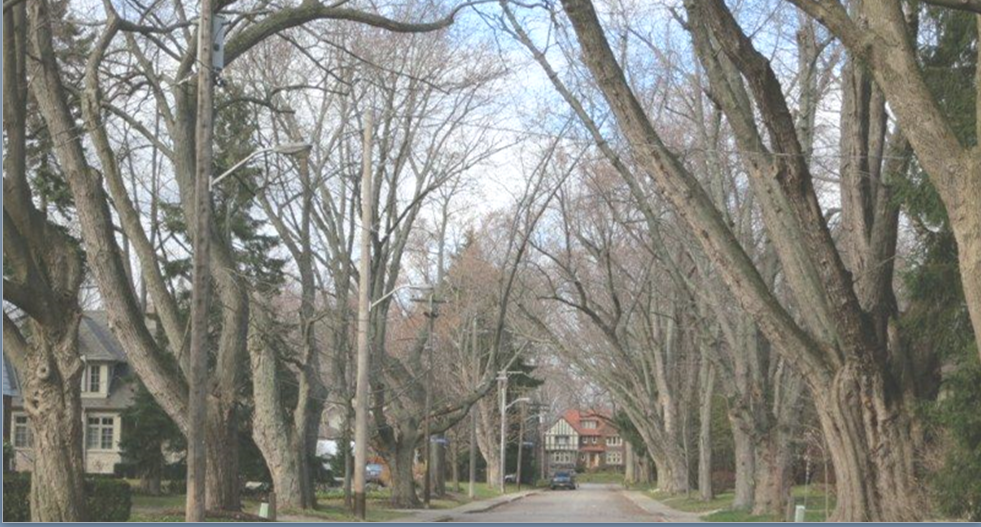 Roseland – where the value of high end homes are threatened by ageing trees. Citizen Action Lab – Citywide Private Tree Bylaw Engagement
Citizen Action Labs are where people work together in small, welcoming groups to engage, discuss, share and explore new ideas.
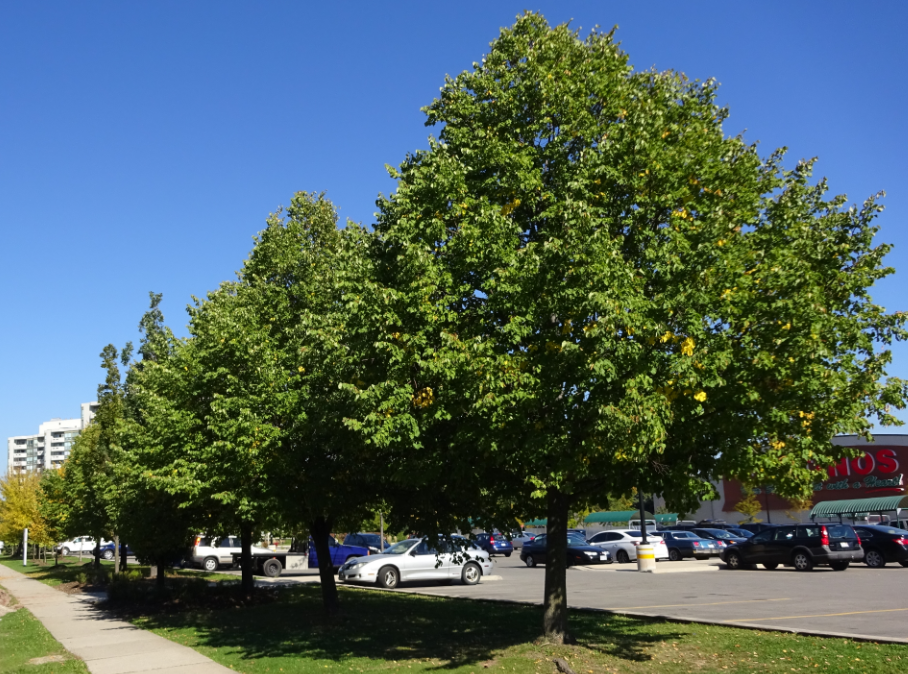 Gorgeous trees – cut down because geese were eating the apples and the church next door didn’t like the Canada geese fouling the parking lot. Residents are encouraged to come to any one of the three sessions planned:
• Saturday, August 24, 9 a.m. to 12 p.m. at Mountainside Recreation Centre Rm 2, 2205 Mt Forest Dr.
• Monday, August 26, 1 to 4 p.m. at Royal Botanical Gardens, Auditorium Rm B.
• Thursday, August 29, 7 to 9 p.m. at Tansley Woods Community Centre Rm 1&2, 1996 Itabashi Way
Businesses such as landscapers, pool companies, homebuilders, general contractors and tree companies are also encouraged to come and learn and provide feedback about the bylaw.
About the Private Tree Bylaw
No person can injure, destroy, cause or permit the injury or destruction of a tree with a diameter of 30cm or greater or of a tree of significance (historic or rare).
To read the full Pilot Private Tree bylaw currently in effect in the Roseland community, including information on permits, exemptions and fines, visit Burlington.ca/PrivateTree.
 Belvenia – probably the most beautifully treed street in the city. Examples of exemptions include:
Trees with a diameter of less than 30cm
For the purpose of pruning in accordance with Good Arboricultural Practices
For emergency work
If the tree has a high or extreme likelihood of failure and impact as verified or confirmed by an Arborist or the Manager
If the tree is dead, as confirmed by the Manager of Urban Forestry, or designate
If the tree is an ash tree (due to the Emerald Ash Borer), as confirmed by the Manager of Urban Forestry, or designate
If a tree is within two metres of an occupied building
For more exemptions, visit Burlington.ca/privatetree
Permits
A person wanting to remove a tree with a diameter larger than 30 cm or of significance can apply for a permit online by visiting Burlington.ca/privatetree.
Fines
Minimum fine is $500. Maximum fine is $100,000.
Burlington is one of Canada’s best and most livable cities, a place where people, nature and business thrive. Sign up to learn more about Burlington at burlington.ca/enews and download the free City of Burlington app.
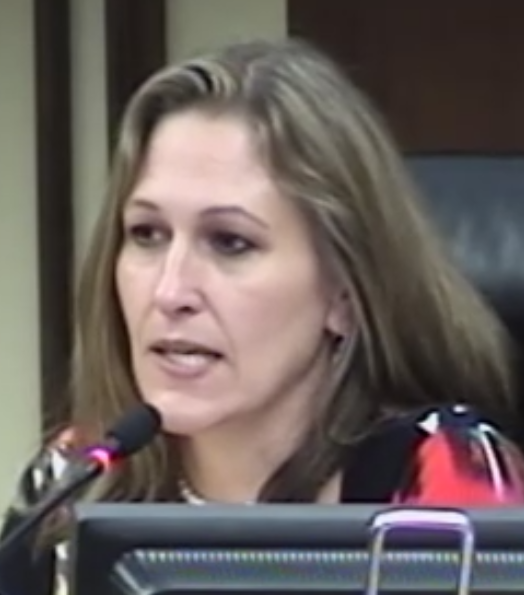 Mayor Meed Ward “…completely supportive of extending the Private Tree Bylaw.” The Goldring city councils just could not get their heads around the need for a private tree by-law – it took them forever to get a by law in place on a pilot basis in the Roseland community. Mayor Meed Ward elected in October made it very clear where she stood.
“I am completely supportive of extending the Private Tree Bylaw, currently underway as a pilot program in Roseland, across our City. I have repeatedly said protecting Burlington’s tree canopy is one of my goals as Mayor because they’re a valuable resource we need to preserve.
“We’re at a crucial point in our City and the time to act is now. Making sure we examine things through a climate emergency-lens, this bylaw makes sense and is needed. It is a realistic and achievable action that we, as a City and as citizens, can do to protect our environment, health and well-being, and help minimize the effects of climate change.”
When city staff went along with a resident’s request to take down a tree so that a drive could be built on a property that was getting a new house built there were just two people who opposed the idea: the ward Councillor and the Mayor – suggesting that this council may not be as supportive of a city wide private tree by law as the Mayor.
Steve Robinson, Manager of Urban Forestry explains that: “Ninety per cent of the City’s urban forest is located on private property. By creating legislation like the Private Tree Bylaw, these assets can be protected as valued parts of our green infrastructure, while they continue to help reduce the effects of climate change. As a community, we must evaluate the feasibility of a bylaw of this magnitude as it has implications to individual residents, but has the potential to yield tremendous results to benefit the community.”

 By Pepper Parr By Pepper Parr
April 4th, 2019
BURLINGTON, ON
ECoB – the Engaged Citizens of Burlington have been watching how the city has decided to engage and consult on the re-assessment and review of the Official Plan.
To complete the work being done ECoB believes the city will have to allow more time and money to get the job done right.
 In a letter sent to their membership ECoB set out their concerns and asked for feedback from the membership. In a letter sent to their membership ECoB set out their concerns and asked for feedback from the membership.
It is essential to note that ECoB was treated with shabby disdain by two of the 2014-2018 council members; one of the two lost her seat, the other, Paul Sharman who held the ward 5 seat because the vote was badly split, has yet to find the decency to admit that he was wrong and support the organization going forward.
ECoB has grown from the outstanding success they had with the Mayoralty debates followed by the “conversation” on the Performing Arts Centre at which people got a close look at how their Mayor did when she went up against Oakville Mayor Rob Burton.
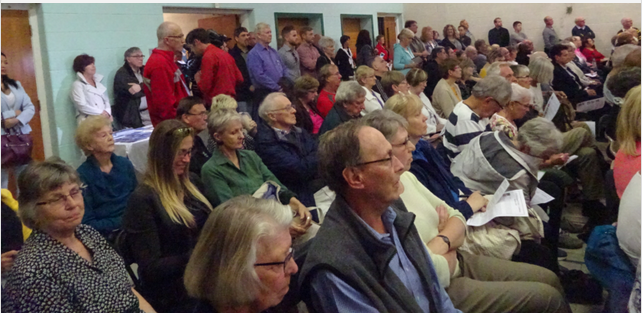 The Aldershot All Candidate debate filled a church hall to standing room only. The event was sponsored by ECob. The organization is now focusing on how and to what degree citizens will have input on the Official Plan that is being re-assesed and revised.
What is clear now is that ECoB has earned a seat at the table; a situation the city has recognized. It is now up to the ECoB members pay attention, keep informed and grow the membership of the organization.
ECoB’s Update on Burlington’s Official Plan Review
“ECoB’s executive and ward committees have been busy in recent months. We will be sending you the first of what will become a monthly newsletter in the next few days.
“But first we wanted to update you on one of the most important things happening at City Hall right now. The Review of Burlington’s Official Plan, which is being reassessed by the City Planning Department following the Region of Halton’s request for certain changes, is now underway. The entire process of review has a very short timeline, and needs to be approved by Council by March 2020.
 “Citizen engagement is the term commonly used for public consultations which offer citizens the opportunity to participate in meaningful ways in the decisions, actions and processes which shape their community. “Citizen engagement is the term commonly used for public consultations which offer citizens the opportunity to participate in meaningful ways in the decisions, actions and processes which shape their community.
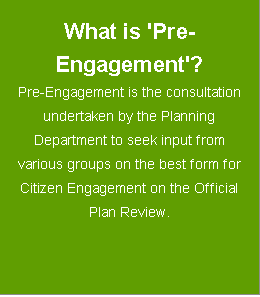
“Pre-Engagement is the consultation undertaken by the Planning Department to seek input from various groups on the best form for Citizen Engagement on the Official Plan Review.
ECoB’s Role in ‘Pre-Engagement’
“The Planning Department has been undertaking a ‘pre-engagement’ exercise in recent weeks in preparation for a new round of Citizen Engagement on the Official Plan. This engagement will relate solely to downtown Burlington.
“The intention of the pre-engagement was to consult with various groups to make sure that the citizen engagement that is carried out for the OP Review is done right.
“Those consulted at this stage included Citizen Advisory Committees, the City ‘Charter Action Team’ (an advisory group tasked with overseeing implementation of the City’s Engagement Charter), ECoB and Hamilton-Halton Home Builders Assoc.
- The Planning Department has provided us with a summary of pre-engagement. Download it here.
- The Planning Department’s Draft Engagement Plan. Download it here.
- Download ECoB’s Response to the Pre-Engagement summary and draft plan.
“ECoB welcomed the opportunity to meet with the Planning Department and provide its ideas regarding a good engagement process. It also welcomes the desire by the City to carry out more rigorous engagement processes than have been seen in the past.
ECoB’s Concerns About Weaknesses In Engagement Plan.
“Nevertheless, there remain concerns about the Draft Engagement Plan and the results of the Pre-Engagement exercise. These are set out in detail in the links above.
“These weaknesses are caused by two constraints – time and money.
“While ECoB acknowledges the urgent need to complete the review and for Burlington to have a new Official Plan, we also believe that it is essential that the most rigorous engagement process possible is undertaken. For the City to provide the Planning Department with a budget too limited to carry out adequate engagement is a fundamental mistake, and risks repeating the mistakes which have made the OP Review necessary. Likewise, if an additional month of engagement would guarantee substantially more rigorous results, that month would be a worthwhile delay. As it stands now the primary citizen engagement that will take place will be in a period of approximately 6 weeks: late August and October..
“Above all, the engagement must reach out beyond traditional public meetings and website questionnaires, which are limited by the self-selecting nature of participation. Many groups – commuters, young families, teenagers, new immigrants – will never participate in traditional engagement exercises. The most important part of the process is to form a representative snapshot of public opinion which ensures the results reflect potential differences in age, gender, ethnic background and more. This requires attempts to reach citizens at home and in ways which don’t require them to ‘opt in’ to participation.
“We therefore urge the City Manager and Council to do all they can to provide more resources, and if possible more time, to the Planning Department to complete as rigorous and representative an engagement exercise as possible.
“From both a symbolic and practical perspective, it is essential the city demonstrates the extent of its commitment to rigorous engagement as part of the Official Plan Review.”

 By Pepper Parr By Pepper Parr
August 3rd, 2019
BURLINGTON, ON
In an announcement made sometime in June, Nelson Aggregates set out its plan to expand its Burlington quarry into the adjacent Burlington Springs Golf Course and a smaller parcel of land to the south.
The announcement added that, “Once operations are complete, Nelson would donate the nearly 1000 acres of rehabilitated land to the public, creating Burlington’s largest park.
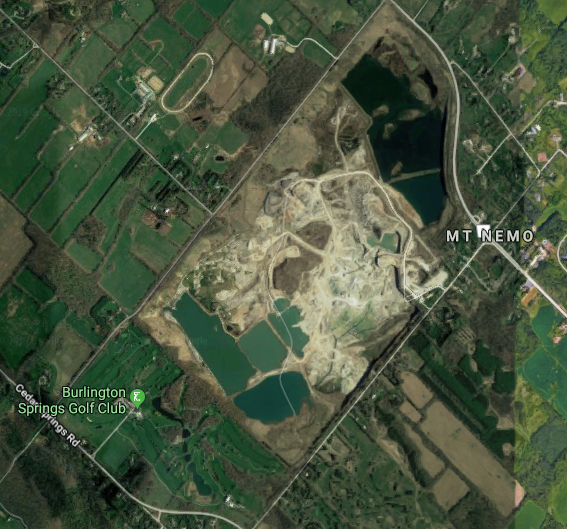 An aerial view of the site. 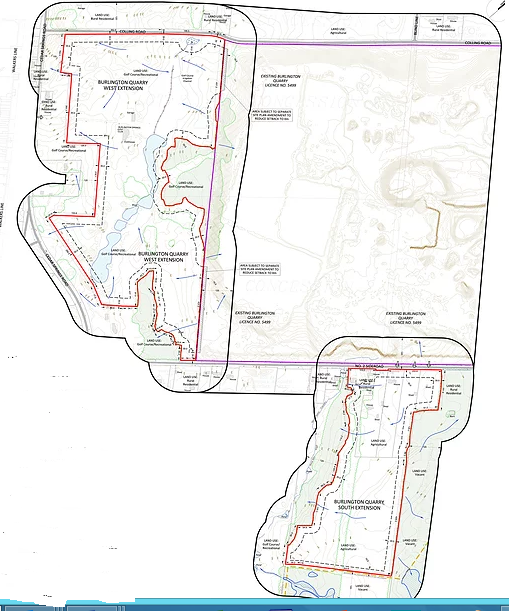 Technical drawings show the south extension – this is the land that was in the 2011 application that was dismissed; and the extension into the golf club property. “This quarry has played an important role as Burlington’s main source of local gravel for 50 years,” said Quinn Moyer, President of Nelson Aggregates. “We would like to see it provide high-quality, low-cost aggregate for another 30 years and then continue to serve the people of Burlington as the city’s largest park.”
The owner and operators of Nelson Quarry plan to close the facility in about 25 years. They are asking the City of Burlington, the Region of Halton, and their neighbours, to help create the largest park in Burlington, the nearly 1000-acre Mount Nemo City Park.
Over the next 30 years, they intend to expand the quarry operations into adjacent properties that they already own. During that same time, they propose to donate the land they are no longer using to the public.
Over that same period, year-by-year, parcel-by-parcel, Nelson proposes to transfer ownership of all the land to the public for recreational purposes.
 The orange line is the boundaries used in the 2011 application that was dismissed – the lower part was the new area Nelson wanted to begin to quarry.
It was on October 11th, 2012 that a Joint Tribunal dismissed the Nelson Aggregate application to expand the quarry.
With the current approach Nelson appears to want to get permission to expand operations into new lands they have acquired with a promise to turn over various parcels of land to the city for a park they claim will be the city’s largest.
The proposed park would be 5.7 times larger than Burlington’s City View Park, and would be donated to the public in stages following approval. The size and scale of the park would allow for abundant recreational opportunities, from biking and swimming to rock climbing and soccer.
What will the park look like?
It would be more than twice the size of High Park in Toronto, and could have dozens of uses, from rock climbing to beaches.
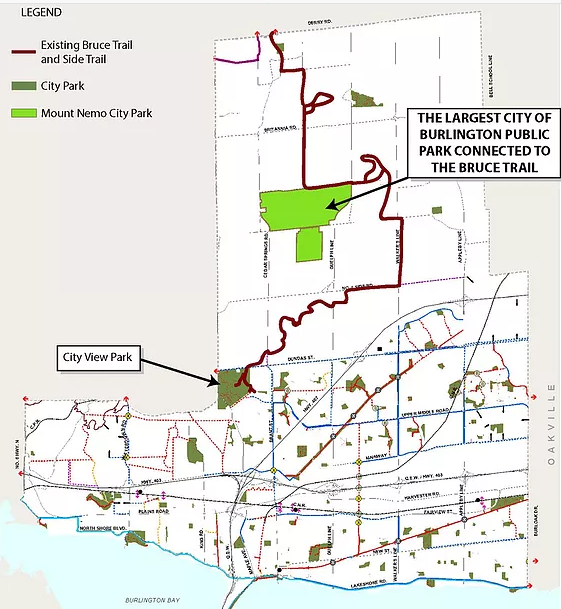 Were the proposed park ever to materialize it would add to the traffic on the rural roads – watch for the howls from those who chose the peace and quiet of the country side that they don’t want destroyed. The expansion Nelson is looking for would encompass 180 acres. The bulk of the proposed expansion is in a different location than a 2004 proposal, (there is some confusion around the 2004 date) and a much smaller extraction footprint of 134 acres is proposed to protect the unique local environment.
“We learned a lot from our 2004 application,” Moyer said. “We heard from residents about what is important to them and we have incorporated that into this plan. We look forward to an ongoing dialogue with the community in the coming months.”
Nelson plans to formally submit its proposal in November. Plans for public consultation will be announced.
It was a rather stunning announcement that amounts to Nelson Aggregates looking for a way to get around the decision made in 2011 to not permit an expansion of the quarry that has been extracting aggregates for more than 50 years. They are now looking for a way to continue doing so for another 30 years.
There will be a community meeting at the Conservation Halton offices on Thursday August 8th
The application will ask to be able to expand to the south and the west.
The first phase of the expansion will be to the south of the existing quarry, across the No. 2 Side road.
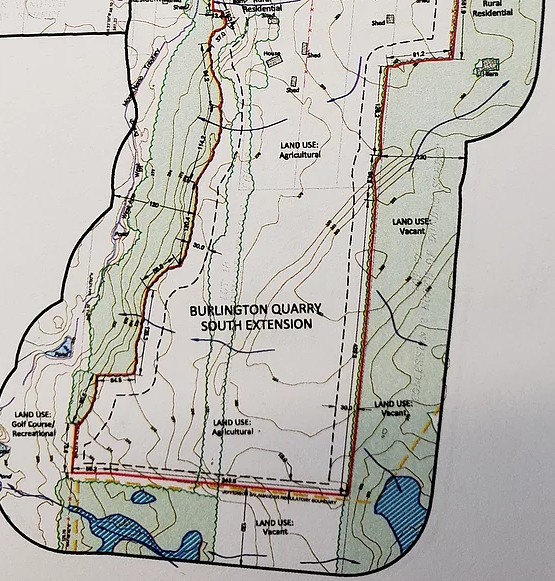 Detail on the southern extension. The proposed area is currently a mix of residential, agricultural and vacant land. This is the land that Nelson wanted to expand into in 2011.
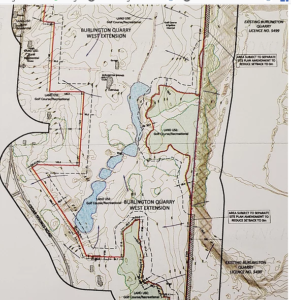 Detail on the expansion into the golf club lands. The westerly expansion would take place beginning in 2025 on the site of the Burlington Springs Golf Course.
Environmental Protection
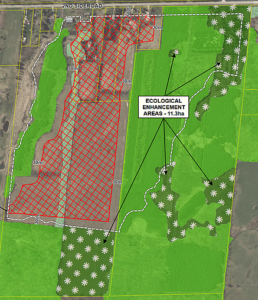 Ecological enhancements to 19 acres around the South expansion; enough to keep the natives happy? “We are committed to continuing to treat the areas around the quarry with the utmost care. In addition to large buffer zones between the quarry and sensitive areas, we are proposing ecological enhancements to 19 acres around the South expansion to enhance the natural habitat and protect water sources”, said Mover.
Based on the information available the plan has four phases.
Phase One
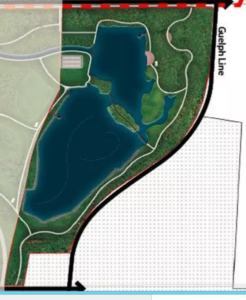 Phase 1 Within three years of our plan’s approval, we will transfer 162 acres of rehabilitated land to the public.
With a large lake system, this area at the east end of the existing quarry already has the potential for water sports, hiking, cycling and an expansion of the Bruce Trail system.
Phase Two
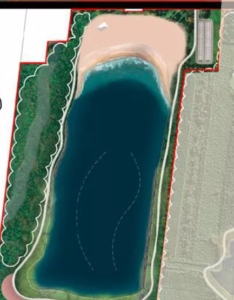 Phase 2 “This nearly 200-acre parcel of land to the south of the quarry will be transferred to the public about 10 years after approval of our continued operations. Its large lake could form the basis of a sandy beach that permits many water sports. It could also include significant natural woodlands and wetlands.”
Phase 3
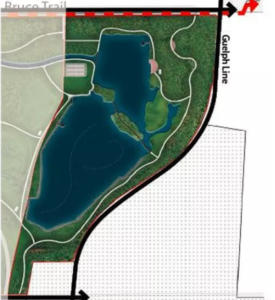 Phase 3 “Ten years after approval, we will transfer the second piece of property to the public. The 100-acre parcel is located to the west of our current operations. It has the potential for 5km of trails, a disk golf course and a clubhouse.”
Phase Four
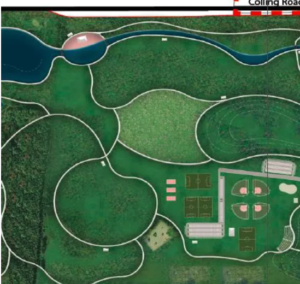 Phase 4 “The final piece of land in the heart of the current quarry comprises nearly 200 acres. It has the potential for 10km of trails, rock climbing, tobogganing, an amphitheater and more. Once donated, it becomes the keystone piece in Burlington’s largest park.”
The key word throughout the detail on each phase is “after approval”. Nelson wants the approval in exchange for a mined out quarry.
Given the fight that citizens in this city put up the last time an application was made by Nelson one would have thought there would be some mention of the issue by the ward Councillor. There is mention of the meeting on August the 8th at the Conservation Authority office on Britannia Road.
Nothing in the Councillor’s June newsletter; the July newsletter has yet to be published.
No mention of the Jefferson Salamander in this new plan.

 By Pepper Parr By Pepper Parr
July 29th, 2019
BURLINGTON, ON
Despite a year of significant upheaval in the Planning department – staff are now working on several critical reports with tight time frames – and developing ways to include the public in the process on an ongoing basis and not when it is all wrapped up.
Planning staff are well into the Work Plan for the scoped re-examination of the Adopted Official Plan.
It is a mammoth task that has to be done right if Mayor Marianne Meed Ward is to meet the mandate the public gave her in October.
 City planner, Heather MacDonald , on the right, in conversation with Blair Smith The Planning and Development Committee set out what the Department of City Building is expected to get done during the summer.
Along with the re-examination of the Adopted Official Plan the City Building Department has to figure out just what they want to allow in the way of development in the city core – now that there is a freeze on all development in the core.
Direct the Director of City Building to proceed with the work identified
Direct the Director of City Building to propose refinements to the Neighbourhood Centre’s Policy to simplify and clarify the intent of the policies, generally described in section 4.2.3; and
Direct the Director of City Building to modify the terms of reference upon confirmation of impacts related to Bill 108 and other Provincial changes to the land use planning and development system, if required.
All this began when city council adopted a new Official Plan. That plan was sent to the Region which is the approval authority for the Official Plan.
On December 4, 2018, the day after the new city council was sworn in, the Region of Halton provided a notice to the City advising that the adopted Official Plan does not conform with the Regional Official Plan in a number of respects. The effect of the notice extends the Region’s review process indefinitely, until such time as the Region determines that the non-conformity is rectified. The supporting information identified that:
The City of Burlington can make additional modifications before the plan is approved by the Region where there is appropriate planning justification and public consultation. Any modifications would need to be assessed for conformity against the Regional Official Plan and Provincial Plans and policy statements.
 The night the election was won. That statement gave the new Mayor a free hand to look at everything in the plan that had been adopted by the previous council despite considerable opposition to the plan from a large portion of the public.
In February, 2019 Council provided a staff direction to re-examine the policies of the adopted Official Plan:
Direct the Director of City Building to immediately commence a process to re- examine the policies of the Official Plan adopted April 26, 2018 in their entirety related to matters of height and intensity and conformity with provincial density targets.
A Council workshop was held on March 18, 2019 to obtain further Council feedback on this direction, which has resulted in the scope of work.
To prepare for the Council Workshop, a series of meetings with Councillors were undertaken. The result of these meetings was a list of issues relevant to each Councillor, which informed the preparation for the Council Workshop.
A number of key themes emerged from the workshop discussion. It was clear that Council agrees that the work identified should be completed by the end of Q1 2020. That is eight months away.
Through discussion at the workshop it was agreed that the adopted Official Plan brings in new policies and forward looking approaches to land use planning and growth. In general, Council supports the majority of the policies within the adopted Official Plan.
Two key areas emerged as requiring further consideration: the Downtown Precinct Plan and the Neighbourhood Centre policies.
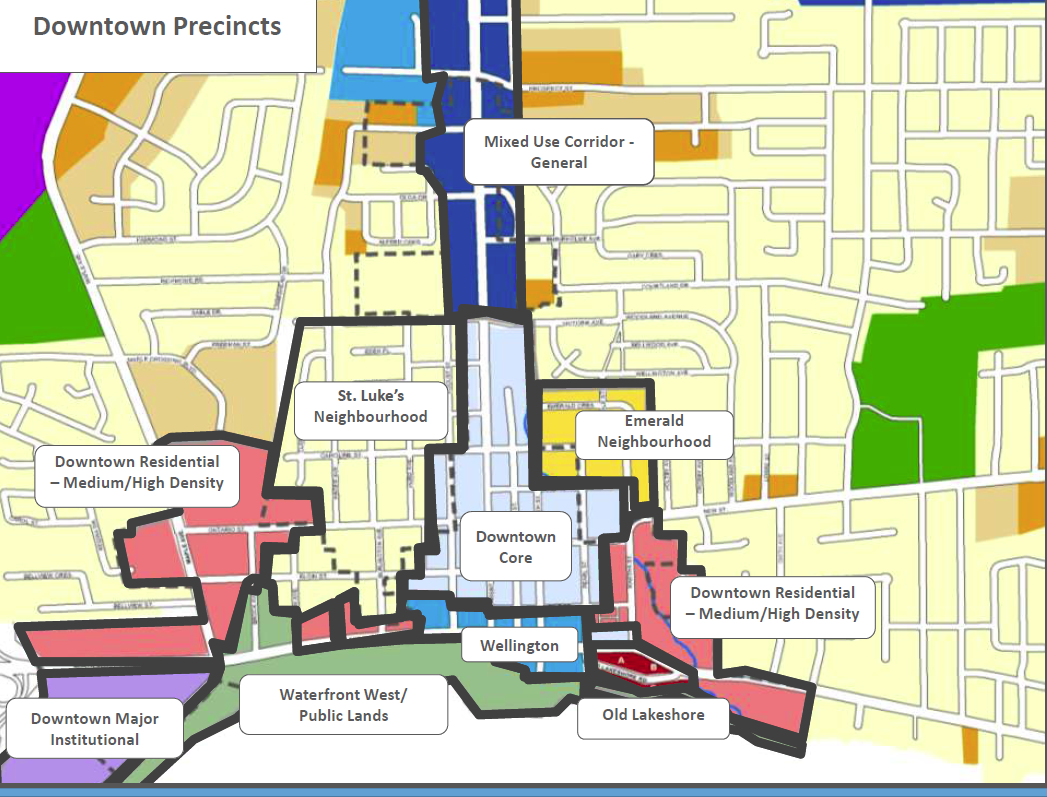 A precinct is not limited to a single given area: it is rather a description of what can be done in an area within the named precinct. It was acknowledged at the workshop that the Official Plan is not intended to provide detailed land use policies for specific sites. As a result there is a role for more detailed land use planning processes. These processes can include both detailed, city-led area specific planning exercises such as area-specific plans, or site-specific development applications for Official Plan and/or Zoning Bylaw Amendments.
Coming up with an Official Plan that could be defended has never been a slam dunk for Burlington. Almost everything they do gets challenged – costing the city a bundle in legal fees and months of work time dealing with the appeals.
To this end, staff and consultants will need to work together to prepare modifications to policies, based on technical information and public and stakeholder input, which demonstrate the functionality and feasibility of a recommended scenario in conformity with the Regional Official Plan and Provincial Plans and policy statements.
It was no surprise to anyone that throughout all the questions and discussions at the workshop was the role community would play – this council was elected to ensure that the community was at the table.
The results had to be reflective of the community’s vision for the future of Burlington;
– Be that residents believe that the Official Plan represents their values for the future of the City;
– Be supported by an effective public engagement process; and
– Be supported by the public.
Staff agree that the work to re-examine the Official Plan must be supported by a public engagement process and a decision-making process that all stakeholders can understand and agree to in principle. As identified generally by Council, this need for public satisfaction of the plan must be married with the desire to develop a plan that is defensible from a land use planning perspective.
In order to achieve success the project team must transparently:
– educate and communicate the givens – the plan must conform to provincial policy.
– identify the questions that are in scope and out of scope;
– collect, analyze and respond to the feedback;
– use the best tools possible to communicate alternatives, short and long-term impacts and their associated benefits and drawbacks;
– describe and continually communicate about decision making processes; and,
– identify process challenges along the way.
It was this need to ensure that the public was informed while the changes were being made and not have a finished plan introduced to an unsuspecting and unaware public that brought out the need for the creation of a communications plan that had input from the public – people sitting at the table with the planners. A major new step for Burlington.
 Bill 108 was not only contentious because of the content but also because of the speed with which is was introduced and made law. Hovering in the background is the impact of Bill 108 which some have described as a Developers Dream Bill. WeloveBurlington provided an excellent over-view of the Bill and its probable impact. Add to this the Provincial Review which is looking at what form the Regional governments will take going forward.
The Strategic Plan, which has up until now been a list of high level values that everyone subscribes to with there being not very much in the way of detail.
Burlington took a different approach – they took the Strategic Plan “vision” and made it the front end of a series of objectives known as V2F – Vision to Focus. There is a detailed list of where in the Strategic Plan this council thinks the focus should be place.
V2F has been labelled “living document”; one that will undergo changes daily if necessary.
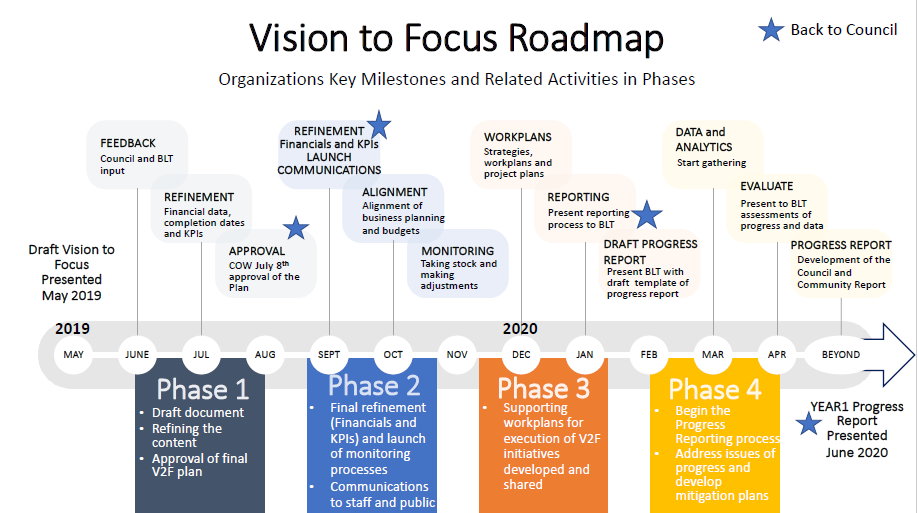 It was another new move on how council was going to proceed and keep the public in the loop. Problem now is for the public to keep up. While all this is going on council has to deal with a number of related high priority initiatives that are identified in the Official Plan and the Strategic Plan such as the Mobility Hub Area Specific Plans and the Housing Strategy.
Tucked in there is the budget this council wants to have in your hands before Christmas.
These Housing and Mobility Hub initiatives have been postponed given Council’s focus on the re-examination of the Official Plan and the Interim Control Bylaw Land Use Study as well as the work addressing areas of non-conformity of the adopted Official Plan with the Regional Official Plan and given the uncertainty related to the Region’s Official Plan Review.
The March Council Workshop identified two key areas of the Adopted Official Plan that must be included in the scoped re-examination of the adopted Official Plan to guide the next year of work:
a modified precinct plan for the Downtown Urban Centre;
and a review of the Neighbourhood Centre’s policy.
In order to get a solid grip on just what the scope of work was Planning department staff had to be fully conversant with what came out of the March Council workshop; the Motions related to the Downtown Urban Centre that were not passed during the adoption process; the non-Official Plan related Council directions identifying issues to be considered through the Downtown Area Specific Plan; the Commercial Strategy Study recommendations related to the Downtown, with specific attention to small scale retail in the downtown; and the details of Interim Control Bylaw Land Use Study.
This is no small matter.
The Downtown Precinct Plan in the adopted Official Plan was based upon a vision at full build out. Council wanted staff to look at a shorter planning horizon which resulted in a modified precinct plan for the Downtown Urban Centre that would have a planning horizon of 2031, in conformity with provincial policy.
The population and employment forecasts contained in the applicable upper- or single-tier official plan, that is approved and in effect as of July 1, 2017, will apply to all planning matters in that municipality, including lower-tier planning matters where applicable.
The background technical work prepared to date for the Downtown area-specific plan, to be finalized through this study, will confirm development constraints and provide clarity on infrastructure capacity and required improvements.
The shift of the scope of this work to the 2031 planning horizon means that there are not likely to be significant infrastructure issues identified through this planning exercise.
The next planning horizon is 2041.
The planners would just like to get what they have in front of them done within the very tight timelines.
The outcome of this work will not constitute an area-specific plan, instead the outcome will be modified policies which will go beyond the high level Official Plan policies that are included in the current adopted Official Plan (April 2018). The modified policies will be developed to ensure that the City can conform with the Growth Plan policy to accommodate 200 people and jobs per hectare combined within the Urban Growth Centre boundary by considering the findings of technical work and public, agency, and stakeholder feedback.
What is going to get a very close review are all precincts within the Downtown Urban Centre where significant concerns regarding height and density were raised by the current Council;
– All precincts impacted by motions not passed when considered by the previous Council in the development and finalization of the adopted Official Plan;
– Specific policies identified to be modified based on the technical work;
– Small scale retail in the Downtown;
– Built form transition to adjacent residential areas;
– Heritage conservation and cultural heritage resources;
– Flexible streets
The Proposed Terms of Reference do not address:
– Shifting the Urban Growth Centre from the downtown to Burlington GO. The Urban Growth Centre location is established in the Growth Plan for the Greater Golden Horseshoe and the Region of Halton Official Plan. Any policies proposed for the Official Plan must conform with both;
– Major Transit Station Area and Mobility Hub role and function in the downtown as they will be considered in the Interim Control By-Law Land Use study and recommendations will inform this study;
– Transportation or infrastructure assessments to support people and jobs beyond 2031.
– Undertaking a Neighbourhood Character Area study for the St. Luke’s and Emerald precincts. Matters of zoning in the St. Luke’s and Emerald precincts will be considered at the time of the Zoning By-law Review;
– The Old Lakeshore Road Precinct. This area requires a more detailed area specific planning process as identified by adopted Official Plan policy. For more details see Appendix B;
– The Waterfront Hotel Site. This site is subject to a process outlined by a Memorandum of Understanding signed by the City and landowner. For more details see Appendix B;
– Revisions to the Downtown Public Service Precinct. It is expected that the development criteria and other policies of the adopted Official Plan provide sufficient guidance for development in the precinct; and,
– Developing parking rates for the Downtown. Parking rates for intensification areas such as the Downtown are to be addressed through the preparation of site-specific zoning.
Interest was expressed in having the Neighbourhood Centre policies in the adopted Official Plan reviewed.
The role of policy in supporting the redevelopment of Neighbourhood Centres is to establish a detailed policy framework to guide the consideration of site specific development applications. Consistent with the Strategic Plan, the policy framework encourages redevelopment of plazas.
Staff has considered the discussion at the Council Workshop and acknowledge that there is an opportunity to simplify and provide further clarity related to the intent of the Neighbourhood Commercial policies and their relationship to the Strategic Plan. This will be led by staff and would be implemented as part of the proposed modifications to the adopted Official Plan. This work will include:
– Identifying opportunities to clarify and describe the intent of the policy;
– Simplifying language; and
– Clarifying the relationship of the land use policies with the growth framework.
The scope of work proposed has a one-year time frame which was identified as a critical success factor. As discussed at the Council Workshop held on March 18th, another consequence of proposing work that would extend the time frame beyond March 2020 is primarily to shift out the initiation of work for a number of planning studies or initiatives by 12 – 18 months.
When all this was being worked out Bill 108 was not yet the law of the land. Now it is. The Province has also released a new Growth Plan and Provincially Significant Employment Zones Mapping.
Funding of $600,000 from the Policy initiatives reserve fund was approved as part of the 2019 budget for Official Plan related initiatives.
While all this work is taking place a group has been meeting with citizen groups to determine how all this complex information can be put before the public on an ongoing basis. The Gazette wrote about that work in an article last week.
Related news story:
Engagement with the public on a much different and highly desirable scale is taking place during the summer.
You have lost control
Weloveburlington on Bill 108

|
|
 The Gazette wondered aloud during a telephone conversation earlier today if this organizational change was not a consolidation of power in the city manager’s office. Commisso doesn’t see it that way. He did reduce the number of direct reports from 17 to 12 and admits that even twelve is a little on the high side.
The Gazette wondered aloud during a telephone conversation earlier today if this organizational change was not a consolidation of power in the city manager’s office. Commisso doesn’t see it that way. He did reduce the number of direct reports from 17 to 12 and admits that even twelve is a little on the high side.































































































 “Citizen engagement is the term commonly used for public consultations which offer citizens the opportunity to participate in meaningful ways in the decisions, actions and processes which shape their community.
“Citizen engagement is the term commonly used for public consultations which offer citizens the opportunity to participate in meaningful ways in the decisions, actions and processes which shape their community.



















